Results 7,801 to 7,810 of 11102
LinkBacks (?)
-
12-26-2016, 11:32 AM
-
09-02-2016, 05:39 PM
-
whole garden made with pallets!! Love it!! | Pallets | Pinterest | Pallets, Pallets Garden and Wooden Pallets
Refback This thread03-06-2016, 11:30 AM -
10-20-2015, 05:29 PM
-
06-12-2015, 08:00 PM
-
02-26-2015, 01:58 PM
-
01-05-2015, 04:13 PM
-
12-19-2014, 10:19 AM
-
EMERGENCY: HUGE FEMA PANDEMIC EXERCISE IN USA IN NOVEMBER, INTERNET SHUT DOWN PART OF EXERCISE | Prepare4Survival
Refback This thread12-03-2014, 10:39 PM -
Off Grid World ? Ugly Duckling Shipping Container Home Built by Artist Is a Beautiful Swan on the Inside
Refback This thread11-25-2014, 03:10 PM -
11-17-2014, 10:59 PM
-
11-13-2014, 11:18 AM
-
11-09-2014, 02:54 PM
-
10-28-2014, 11:38 PM
-
10-26-2014, 05:54 AM
-
10-16-2014, 11:28 AM
-
10-03-2014, 01:25 PM
-
10-02-2014, 09:16 PM
-
09-26-2014, 07:00 PM
-
09-26-2014, 01:56 PM
-
09-19-2014, 04:46 PM
-
09-13-2014, 05:49 AM
-
09-05-2014, 01:52 PM
-
09-01-2014, 09:39 AM
-
08-30-2014, 06:29 PM
-
08-10-2014, 06:29 AM
-
08-04-2014, 05:07 PM
-
07-23-2014, 11:14 AM
-
New Evidence on Expiration Dates | Medical Preparedness | Doom and Bloom (TM) | Doom and Bloom (TM)
Refback This thread07-22-2014, 10:10 AM -
07-18-2014, 08:37 PM
-
07-15-2014, 04:57 PM
-
07-11-2014, 01:40 AM
-
04-22-2014, 11:14 AM
-
04-18-2014, 12:57 PM
-
04-18-2014, 10:10 AM
-
04-14-2014, 12:18 AM
-
04-12-2014, 02:28 AM
-
03-02-2014, 11:43 PM
-
12-24-2013, 11:59 PM
-
12-07-2013, 11:04 PM
-
kitchen | Cob
Refback This thread11-25-2013, 03:24 PM -
10-22-2013, 10:25 PM
-
Apple Pie Braid | Sweets
Refback This thread09-26-2013, 07:58 AM -
09-02-2013, 04:44 PM
-
5 Reasons Why You May have to Bug Out Even Though You Don’t Want to | The Apartment Prepper's Blog
Refback This thread08-23-2013, 03:20 PM -
06-27-2013, 06:30 AM
-
06-23-2013, 08:11 PM
-
06-17-2013, 11:21 PM
-
05-24-2013, 05:06 PM
-
To Eat / BASIC LIST / SUGGESTED ITEMS FOR LONG TERM SURVIVAL - Page 275 - ALIPAC
Refback This thread05-01-2013, 03:49 AM
Thread Information
Users Browsing this Thread
There are currently 1 users browsing this thread. (0 members and 1 guests)
-
07-10-2023, 01:45 PM #7801
Foods That Unclog Arteries (Most People Ignore)
Amy S. June 13, 2023 No Commentson Foods That Unclog Arteries (Most People Ignore)

Your arteries are the largest of your body’s blood vessels, and they play the crucial role of delivering oxygen and nutrients to every organ, tissue, and cell. So, to say that keeping these vital channels in tip-top shape is important for your health is a bit of an understatement.
But millions of Americans are plagued by unhealthy arteries. They have what’s called atherosclerosis—an inflammatory condition where plaques (fatty deposits composed of cholesterol and other substances) build up inside arteries, which interferes with normal blood flow and can lead to heart disease, heart attacks, and stroke. Per some estimates, atherosclerosis is the underlying cause of 50% of all deaths in Westernized society, and it’s the major underlying cause of strokes and Alzheimer’s disease.
The good news: There’s plenty you can do from a dietary perspective to curb your risk for atherosclerosis and even reverse the plaque buildup that’s already there.
Quick Glossary Of Terms
A list of definitions for terms used throughout this article:
Antioxidant – Compounds that help protect your cells and tissues from oxidative damage caused by molecules known as free radicals.
Free radicals – Unstable molecules that rob other cells of electrons (causing oxidation), which contributes to a range of diseases. Free radicals are natural byproducts of metabolism, but things like pollution, UV light, and highly processed foods can drive unhealthy levels.
Polyphenols – A broad category of beneficial plant compounds (or phytochemicals) with antioxidant properties that appear to offer protection against heart disease, certain cancers, diabetes, and other diseases.
Flavonoids/Flavonols – A subtype of polyphenol compounds known for their antioxidant and anti-inflammatory properties. Many flavonoids are responsible for the vivid colors found in fruits and vegetables.
Insulin resistance – A condition in which cells in your muscles, liver and fat don’t respond well to the hormone insulin, and thus cannot easily take up glucose (or sugar) from your blood. Over time, this may lead to type 2 diabetes and damage the lining of arteries.
LDL cholesterol – Low density lipoprotein (LDL) cholesterol is often referred to as the “bad” cholesterol. LDL particles — particularly small dense LDL (sdLDL) and oxidized LDL — can build up on the walls of your blood vessels and arteries as plaque and contribute to heart attack and stroke.
*
What causes plaque buildup in arteries, anyway?
A common misconception about arterial plaque (atherosclerosis) is that it’s mainly caused by high LDL cholesterol levels. But the thinking in this area is evolving, and Dr. Ford Brewer, MD, MPH, a board-certified preventative & occupational medicine specialist, says it’s only a small part of the picture.

So what’s the big culprit?
“Insulin resistance—having prediabetes or diabetes—is the most common cause of atherosclerosis, and therefore heart attack and stroke, kidney disease, blindness, etc,”
says Dr. Brewer.
“LDL matters, but only a fraction as much.”
Typically, he adds, insulin resistance is caused by a high-sugar, high-carb diet or having excess body fat.
According to the Centers for Disease Control and Prevention, around a third of Americans have insulin resistance, a condition in which cells in your muscles, fat, and liver don’t respond well to insulin and can’t easily take up glucose (or sugar) from your blood. This, in turn, elevates levels of insulin and glucose in the bloodstream, which creates widespread inflammation, and can damage the lining of arteries over time.
“The damage weakens the arterial lining and makes it easier for cholesterol molecules to enter through the artery wall,”
says Dr. Brewer.
“This cholesterol builds up inside the artery as plaque, which narrows the opening in the artery.”
Not only does this slow blood flow, but plaque accumulation in arteries prompts your body to release immune cells that attack the plaque, which makes it less stable, explains Dr. Brewer. This unstable liquid plaque can then squirt into the artery, causing a clot—and as we know, clots can result in serious heart problems and stroke.
How dietary changes help keep atherosclerosis at bay
As mentioned above, the main contributors to insulin resistance—and thus atherosclerosis—are a high-sugar or high-carb diet, and being overweight or obese. The good news? These risk factors, along with elevated LDL cholesterol (which is a lesser contributor to atherosclerosis), can be addressed with strategic dietary shifts.
From a broad perspective, eating a diet rich in anti-inflammatory, antioxidant-rich foods (think: veggies, low-glycemic fruits, nuts, seeds, fish, olive oil), scaling way back on sugar, and swapping out refined grains like bread for small quantities of whole grains like quinoa is a smart idea. This way of eating is ideal for maintaining balanced blood sugar (and thus preventing insulin resistance), and it has been shown to reduce risk of atherosclerosis and heart disease.
Just keep in mind, even whole grains can be a significant source of carbs, so to minimize fluctuations in blood sugar, pair them with a healthy fat or protein. If you own a glucometer, you can test your blood glucose levels after eating to see which grains—if any—you tolerate best.
Feeling extra motivated? Eat more of the specific foods below, which have been studied for their cardiovascular benefits and may help naturally unclog arteries by supporting balanced blood sugar, weight loss, curbing inflammation, and lowering LDL cholesterol.
- Medicinal Garden
- With your seeds kit, you’ll also receive a FREE Medicinal Guide that shows you how to turn these 10 plants into tinctures, ointments, salves, poultices, decoctions, infusions, essential oils —all in minute detail so you can follow our guide even if you’ve never made an herbal medicine in your life.
- Fatty Fish
Fatty fish, including salmon, sardines, anchovies, and mackerel, are a potent source of omega-3 fats — powerfully anti-inflammatory unsaturated fats that have protective effects against vascular inflammation and atherosclerosis. Omega-3s can also reduce platelet aggregation (which reduces risk of blood clots), lower triglyceride levels, and increase levels of good HDL cholesterol, which helps counteract the plaque-depositing effects of unhealthy LDL cholesterol.
Additionally, research shows that people who eat 2+ servings of fish per week are less likely to develop atherosclerosis in their carotid arteries.
- Flax Seeds
*Flax seeds are also a good source of anti-inflammatory plant-based omega-3s (alpha-linolenic acid), along with fiber, and antioxidant plant compounds called lignans. Regular flaxseed intake has been associated with decreased blood sugar and insulin levels, and improved insulin sensitivity, among overweight and obese individuals with prediabetes. And preliminary research on animals suggests that regular flax consumption can help halt the progression of atherosclerotic plaques.
Just keep in mind: Whole flax seeds aren’t fully broken down during digestion, so to reap their full benefit, opt for ground flax seeds and store them in the fridge.
- Berries
Blackberries, blueberries, raspberries, and strawberries pack a big punch when it comes to arterial health. These deeply hued fruits are chock-full of polyphenol compounds such as quercetin and anthocyanins, which exert powerful anti-inflammatory and antioxidant effects. Thanks to these compounds (and a nice dose of fiber), berry consumption has been linked to improvements in LDL cholesterol, blood pressure, and even blood sugar control — all of which help keep arteries clear and healthy.
Compared to other fruits like grapes, oranges, and apples (which are high in a form of sugar called fructose), berries are a particularly great choice for regular consumption because they’re low glycemic, i.e. they’re unlikely to spike blood sugar.

- Citrus Fruits
Citrus is jam-packed with polyphenol compounds called flavonoids. These citrus bioflavonoids have powerful antioxidant properties, meaning they scavenge free radicals that might otherwise cause oxidative stress and drive disease processes. Specifically, citrus bioflavonoids can help prevent LDL cholesterol from turning into an even more damaging, inflammatory form of cholesterol known as oxidized LDL, which is strongly associated with atherosclerosis. A study found that eating a grapefruit a day significantly reduced cholesterol and triglyceride levels in people who had just undergone coronary bypass surgery.
Lower sugar citrus foods are best. Opt for grapefruit (as long as it doesn’t interfere with any of your medications) or add a squeeze of lemon or lime to your water for a bioflavonoid boost. *
- Extra virgin olive oil
Higher intake of olive oil is associated with reduced risk of death and cardiovascular events like heart attack and stroke. What sets olive oil apart? It’s a rich source of monounsaturated fatty acids (MUFAs) and polyphenol antioxidant compounds. Research has shown that diets rich in MUFAs are associated with increased “good” HDL cholesterol and reduced “bad” LDL cholesterol; while extra virgin olive oil’s polyphenols help lower inflammation, reduce platelet aggregation, prevent LDL oxidation, and reduce blood pressure.
Olive oil also has a beneficial effect on blood sugar—according to one meta-analysis, people c
onsuming the most olive oil had, on average, a 16% reduced risk of developing type 2 diabetes and reductions in hemoglobin A1c (HbA1C), an measure of average blood glucose over several months.
- Avocado
Avocados deliver a one-two punch for cleaning out your arteries. Like olive oil, avocados contain loads of blood sugar-stabilizing, cholesterol-optimizing MUFAs. But they’re also a surprisingly great source of fiber, clocking in at about 6.5 grams per half avocado. A recent study also found that eating one avocado per day is associated with reductions in LDL cholesterol.
While some people are wary of eating avocados because they also contain some saturated fat, you don’t have to worry about that, says Dr. Brewer. Although saturated fat intake may increase LDL cholesterol, it typically only increases the larger, “bouncier” LDL particles that are less likely to stick to artery walls and cause damage than small, dense LDL particles. Additionally, most recent research has found no beneficial cardiovascular effects of reducing saturated fat intake.
- Legumes
If you tend to eat a lot of grain-based side dishes, consider swapping them for legumes (beans, peas, chickpeas, lentils). These pack a hefty dose of fiber, including soluble fiber, which can help prevent atherosclerosis by lowering LDL cholesterol. Even one serving of beans per day has been associated with significantly reduced LDL. Legumes have also been linked to reductions in blood pressure and chronic inflammation, both of which are contributors to atherosclerosis and blood vessel damage.
According to the American Diabetes Association, beans are relatively low on the glycemic index, which means they’re unlikely to spike blood sugar even though they contain some carbohydrates. However, Dr Brewer warns that, among certain individuals, legumes may elevate blood sugar. He advises many of his patients to ‘eat to the meter’ (glucose meter), especially with lentils, as these can be particularly problematic for prediabetics. Pairing legumes with a source of fat and/or protein can curb their blood sugar spiking potential.

- Tomatoes
Tomatoes, especially cooked tomatoes and tomato sauce, are a great source of lycopene — a powerful plant compound responsible for tomatoes’ red color, and which has been associated with increased “good” HDL cholesterol. In one study, people eating a diet rich in lycopene from tomato products were 17-26% less likely to develop heart disease; and in another study, higher blood levels of lycopene were associated with lower risk of stroke. Pro tip: Fat increases your body’s absorption of lycopene, so add a glug of olive oil to that pasta sauce. - Allium Vegetables
Higher intake of allium veggies (and cruciferous veggies, which we’ll cover below) has actually been associated with a reduced risk of death from atherosclerotic vascular disease. Allium veggies like garlic, onions, leeks, chives, scallions, and shallots are all rich in organosulfur compounds, which, according to several studies, may help reduce blood pressure, cholesterol, inflammation, and platelet clumping — all of which are great for keeping arteries free and clear. - Cruciferous Vegetables
Like allium vegetables, cruciferous vegetables (think: broccoli, cauliflower, brussels sprouts, arugula, cabbage) also contain organosulfur compounds and may reduce your risk of death from atherosclerosis. And further research has found that consuming all vegetables, especially cruciferous vegetables, is associated with thinner, healthier carotid artery walls (thick artery walls, on the other hand, are a marker of atherosclerosis). Cruciferous veggies also contain blood sugar-stabilizing, cholesterol-lowering fiber. - Walnuts
Nuts are a good source of protein, fiber, and healthy fats, and regular nut consumption has been associated with a reduced risk of overall cardiovascular disease and coronary heart disease, which occurs when plaque buildup restricts blood flow to the heart. Of all nuts, walnuts contain the highest levels of heart-healthy, plant-based omega-3s. In an impressive animal study, consuming walnuts as part of a high-fat diet resulted in a 55% reduction in atherosclerotic plaque development compared to control diets. - Beets
Red, golden, and rainbow beets may be controversial in the flavor department — with a notable earthiness — but there’s no question they’re good for supporting healthy blood flow. Beets and beetroot juice are some of the best sources of beneficial dietary nitrates, which are converted to nitric oxide (NO) in the bloodstream. NO relaxes and widens blood vessels, which lowers blood pressure and helps prevent damage to artery walls that could make them more vulnerable to narrowing and plaque buildup. To mellow beets’ earthy flavor, try roasting them with olive oil or toss them into a smoothie. - Spinach
Like beets, spinach and other dark leafy greens are a good source of dietary nitrates, which support supple, f - ree-flowing blood vessels and arteries by boosting NO production. Additionally, leafy greens contain fiber and a range of micronutrients, including folate. Folate plays a key role in cardiovascular health by lowering levels of the amino acid homocysteine. High blood levels of homocysteine are a known risk factor for atherosclerosis, as they can damage the lining of blood vessels and increase arterial plaque buildup.
- Dark chocolate
Dark chocolate is a potent source of polyphenol compounds, specifically cocoa flavanols, which have been shown to help lower blood pressure and improve blood flow (by boosting nitric oxide production), lower inflammation, and prevent blood clots. Some research even suggests that cocoa flavanols help recruit our body’s own stem cells (specifically, endothelial progenitor cells) to help repair damaged blood vessels and grow new ones — which is key for preventing and reversing the vascular damage that can clog arteries and lead to heart disease. - Opt for a low to no-sugar dark chocolate that’s 70% cocoa or higher (or use unsweetened cocoa powder in a smoothie) and consider pairing it with some walnuts to keep blood sugar levels stable.
- Spices
Flavorful herbs and spices are often potent sources of beneficial compounds that can benefit the heart and arteries — even cinnamon, which you probably have in your pantry already. Research suggests that cinnamon intake may be associated with reduced levels of HbA1C and blood pressure among patients with type 2 diabetes. Meaning, this spice could help counter the negative effects of insulin resistance that contribute to atherosclerosis - Cinnamaldehyde, an organic compound in cinnamon, has also been shown to have anticoagulant properties that may help curb risk of blood clots; and preliminary research suggests that cinnamon inhibits the atherosclerosis process in animals with high cholesterol.
- Some other spices that show promise in curbing various atherosclerosis risk factors include ginger, turmeric, and garlic.
- Green Tea
You can sip your way to clear, healthy arteries, too. In one meta-analysis, researchers calculated that each daily cup of green tea corresponded to a 5% lower risk of death caused by cardiovascular disease. And, in another study, green tea consumption was associated with a decrease in vascular cell adhesion molecules, which are proteins released in response to inflammation that cause cells to stick to surroundings and each other — meaning, they can be a big contributor to clogged arteries. The magic lies with green tea’s polyphenol compounds called catechins, which have powerful antioxidant and anti-inflammatory effects. - What about fasting diets?
- Given the popularity of intermittent fasting and water fasting diets (in which you typically eat all of your food within a specified daily window, and consume nothing but water, tea, or coffee outside of that window), you may be wondering if they could help dissolve arterial plaque, too. After all, they’ve shown some promise for weight loss.
- While the research in this area is still young, intermittent fasting (or IF) does seem promising for preventing arterial plaque buildup. In a 2019 research review, authors write that “intermittent fasting inhibits the development of atherosclerotic plaque by reducing the concentration of inflammatory markers, such as IL-6, homocysteine, and [C-reactive protein].”
- In another recent review, published in the renowned New England Journal of Medicine, authors were similarly optimistic, citing that IF improves a range of cardiovascular health markers in human and animal studies, including blood pressure, LDL and HDL levels, and insulin resistance. Additionally, they write, “intermittent fasting reduces markers of systemic inflammation and oxidative stress that are associated with atherosclerosis.”
- Of course, there are many styles of intermittent fasting, so if you’re planning to try it, seek out the guidance of your doctor or a registered dietitian.
The Home Doctor
Do you know about the gift of nature to save the life of people from various health problems and make them feel secure by curing significant issues? How to live healthy in this world without having chronic diseases or illness or any other health issues which may hurt you physically and mentally? Due to dense population, people are trying to demolish the forest, garden areas to create shelter, so they forced to destroy the nature’s gift such as natural ingredients, secret medicinal herbs and more which are grown in wild forest, mountains and other places. When you read this review entirely, sure you will get chance to know about secrets medicinal ingredients, herbs and more used by our ancestor to get back the lost health without losing your life. Claude Davis was highlighted all the stuff in the form of the e-bookThe Home Doctor filled with a list of natural ingredients and remedies that you can quickly grow in the backyard or at free space to include it in your routine diet or external usage to get well soon.
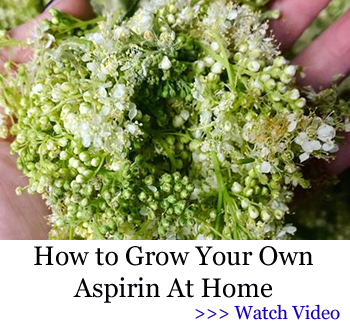
Books can be your best pre-collapse investment.
Carnivore’s Bible (is a wellknown meat processor providing custom meat processing services locally andacross the state of Montana and more. Whether your needs are for domestic meator wild game meat processing)
The Lost Book of Remedies PDF ( contains a series of medicinal andherbal recipes to make home made remedies from medicinal plants and herbs.Chromic diseases and maladies can be overcome by taking the remediesoutlined in this book. The writer claims that his grandfather was taughtherbalism and healing whilst in active service during world war twoand that he has treated many soldiers with his home made cures. )
Easy Cellar(Info about building and managing your root cellar, plus printable plans. The book on building and using root cellars – The Complete Root Cellar Book.)
The Lost Ways (Learn the long forgotten secrets that helped our forefathers survive famines,wars,economic crisis and anything else life threw at them)
LOST WAYS 2 ( Wordof the day: Prepare! And do it the old fashion way, like our fore-fathers did it and succeed longbefore us,because what lies ahead of us will require all the help we can get. Watch this video and learn the 3 skills that ensured our ancestors survival in hard times offamine and war.)
Foods That Unclog Arteries (Most People Ignore) - PrepperFortress
If you're gonna fight, fight like you're the third monkey on the ramp to Noah's Ark... and brother its starting to rain. Join our efforts to Secure America's Borders and End Illegal Immigration by Joining ALIPAC's E-Mail Alerts network (CLICK HERE)
-
07-10-2023, 01:47 PM #7802
THE IMPRESSIVE HEALTH BENEFITS OF WILD GARLIC
Amy S. June 8, 2023 1 Commenton THE IMPRESSIVE HEALTH BENEFITS OF WILD GARLIC
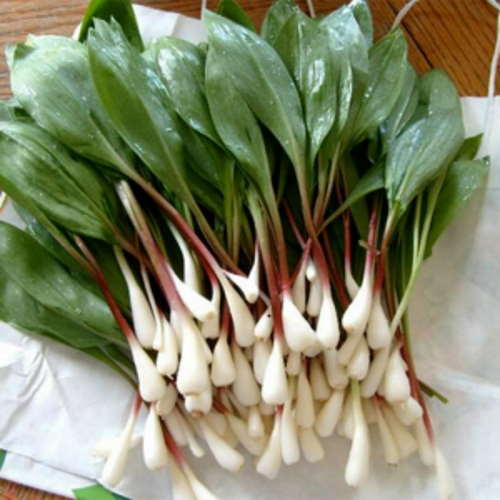
Plant Description
Wild Garlic is a monocot bulbous, perennial herbaceous plant that grows about 12 feet (3.7 m) tall. The plant is found growing in moist deciduous forests, valleys and along streams and normally favors moist soils, preferring slightly acidic conditions. The plant has upright and thin bulb that is white or yellow in color. The plant produces small rounded bulbs on branched rhizomes. The stem is triangular in shape and the leaves are similar to those of the lily of the valley. Every year, leaves appear in late winter, flowers bloom in spring, and seeds mature by mid-summer at which point the plants die back and go dormant until the following late winter.
Leaves
The plant consists of bright green, entire, elliptical leaves that are long, pointed and oval in shape with untoothed margins up to 25 cm long x 7 cm wide with a petiole up to 20 cm long. Leaves grow from the plant base, from the bulb of the plant itself. If bruised or crushed, the foliage emits a strong onion/garlic-like aroma. Wild garlic plants typically have 2 or 3 leaves, but older, well-established plants may have more.
History
Bear’s garlic (Wild Garlic) boasts a very long history of use. The 1st-century Greek botanist Pedanius Dioscorides stated it in his five-volume herbal encyclopedia, describing its effectiveness for the cleansing and detoxification of the body. During the middle Ages, King Charlemagne of present-day France classified the plant in his Capitulare de Villis imperialibis, a guide that highlighted the medicinal properties of common herbs.
In 1992, bear’s garlic was named Plant of the Year by the Society for the Protection and Investigation of European Flora. Although easily overshadowed by its more lucrative relatives, bear’s garlic still holds the same wonderful health benefits that initially earned it the esteemed title. Today it is found in several parts of the world due to its wonderful health promoting benefits and amazing addition to different cuisines.
Flower & Fruit
The inflorescence is an umbel of six to 20 white flowers only, lacking the bulbils. The flowers are star-like with six white tepals, about 16–20 mm in diameter, with stamens shorter than the perianth. Six petals make up a flower, with around 25 of these forming the rounded shaped flower cluster. Flowers are on leafless stalks. Umbellate garlic-scented flowers produce capsules which has black seeds inside.
Leaves and flowers may be eaten raw in the form of salads or cooked as an addition to soups, sauces or stews. Leaf flavor begins to drop as the flowers start to bloom. Underground bulbs can also be eaten raw or cooked.

Health benefits of wild garlic
Garlic is widely known for its antibacterial, antibiotic and possibly antiviral properties, and contains vitamins A and C, calcium, iron, phosphorus, sodium and copper. Studies have also shown that it may help reduce blood pressure, thereby reducing the risk of stroke and heart disease. Interestingly, although all types of garlic have these benefits, wild garlic is thought to be the most effective at lowering blood pressure.
Although we can eat wild garlic bulbs, they tend to be too small to be of much use and digging them out would remove the plant for foraging next year. It’s their leaves that are worth harvesting, preferably before too many of their pretty white flowers have appeared which can signal the arrival of tougher leaves and a slightly bitter taste. Eaten raw, the leaves are delicious, but can pack quite a powerful and pungent punch. When cooked, they mellow considerably while still retaining that gorgeous garlic flavour and scent. The flowers are edible, too, so why not add a handful to garnish your spring salad?
Health benefits of Wild Garlic
Medicinally speaking, there are several remarkable uses for wild garlic, including in the treatment of high blood pressure, high cholesterol, stomach upset, and chronic disease, among others. This particular garlic can be used internally or topically as an herbal supplement or added to poultices and other home remedies. Listed below are some of the well-known health benefits of using wild garlic in your everyday routine

- Treats Chronic Diseases
Active ingredients in wild garlic have the ability to neutralize free radical activity before it can lead to cellular mutation and oxidative stress in different parts of the body. This can help to lower your risk of cancer and other chronic diseases, such as heart disease or arthritis.
- Improves Heart Health
Garlic is known to have a soothing effect on high blood pressure, which can lessen your risk of atherosclerosis, heart attacks, and strokes. Additionally, wild garlic is able to lower overall cholesterol levels, keeping your heart in good shape as you age.
- Treats Stomach Issues
Antibacterial and anti-fungal compounds found in this wilder form of garlic can help to re-balance the bacterial flora in your gut, which helps to calm inflammation, bloating, cramping, constipation, and other stomach issues you may be handling.
- Antibacterial effect
It was already shown that garlic has strong antibacterial effects. But the effect is to feel really strongly, take fresh, rough leaves. Wild garlic helps to cleanse the stomach-intestinal system of microbes and bacteria. So, its regular consumption can be used as prophylaxis against serious illnesses, including cancer.
- High cholesterol and blood pressure
Due to the presence of some important minerals Wild garlic leaves still young is recommended to people who suffer from high cholesterol level and triglycerides in their blood, as well as high blood pressure. This plant has a beneficial effect to the arteries and it can also prevent atherosclerosis.
- Inflammations and infections

Consumption of fresh wild garlic has a beneficial effect on the parasites in the intestines. It helps to prevent the intestines from irritations and also protects the organism from colds and flu. It helps in the treatment of bronchitis, because it clears the airways, relieves breathing and decreases cough.
- Good for the skin
Wild Garlic in the form of bath is ideal for everyone who suffers from problematic skin, inflammatory processes on the skin, skin irritation, eczema and dermatitis.
- Decrease aggravations and allergies
Utilization of crisp wild garlic has a profitable impact on the parasites in the digestion tracts. It keeps the digestion tracts from issues such as ulcers furthermore shields the living being from colds and influenza. It helps in the treatment of bronchitis, since it clears the berating routes, mitigates breathing and prevents cough.
- Helps in Detoxification
Recuperating properties of wild garlic are additionally proficient for purifying the body from poisons. To be more exact, wild garlic cleans the liver, kidneys, insides and nerve bladder.
- Against fatigue
Fatigue during season changes afflicts many people. It is often the lack of certain vitamins – calcium, potassium, iron, etc. fatigue can be overcome very well and quickly with the help of the Bärlauchs. The plant has these and many other important vitamins and minerals in itself.
Traditional uses and benefits of Wild Garlic
Ramsons produce sulfide compounds similar to those found in garlic and onions, and appear to have similar medicinal effects, including antifungal and antimicrobial properties and cardiovascular benefits.
It is particularly effective in reducing high blood pressure and blood cholesterol levels.
It is recognized as having a good effect on fermentative dyspepsia.
Plant is anthelmintic, antiasthmatic, anticholesterolemic, antiseptic, antispasmodic, astringent, cholagogue, depuritive, diaphoretic, diuretic, expectorant, febrifuge, hypotensive, rubefacient, stimulant, stomachic, tonic and vasodilator.
Ramsons ease stomach pain and are tonic to the digestion, so they can be used in the treatment of diarrhea, colic, wind, indigestion and loss of appetite.
Whole herb can be used in an infusion against threadworms, either ingested or given as an enema.
Herb is also beneficial in the treatment of asthma, bronchitis and emphysema.
Juice is used as an aid to weight loss and can also be applied externally to rheumatic and arthritic joints where its mild irritant action and stimulation to the local circulation can be of benefit.
Bear garlic is a wonderful Immune booster.
It combats heart disease like Angina and Palpitation.
Asthma and bronchitis are effectively treated by bear’s garlic.
It takes good cure of the stomach and helps in treating indigestion, Anorexia and stomachache.
It is applied on the skin to alleviate skin rashes.
Garlic chives improve kidney function and are used to treat urinary incontinence, kidney and bladder weakness
Seeds can be used to treat nausea and vomiting
Leaves can be made into a poultice together with Gardenia Augusta and used to treat knee injuries.
If you have problems with high blood pressure, try adding wild garlic to your spring diet.
Wild garlic can provide help to people with frequent migraines.
Juice can be used as a rub to treat joint pain, and can also apparently be used to aid weight loss.
Bear’s garlic wine is an extremely healing agent for the elderly suffering from persistent pulmonary catarrh and related breathing problems.
It is also recommended in cases of pulmonary tuberculosis and dropsy, from which older people often suffer.
It has beneficial effects on the urinary system.
Bear’s garlic can be used as a bath for treating eczema, dermatitis, hematomas and wounds.
Pulverized dried wild garlic leaves are used to prevent ischemic and arrhythmias disease.
Extract from the bulb are also used to treat blood pressure and platelet aggregation.

Culinary Uses
Ramsons leaves are edible; they can be used as salad, spice, boiled as a vegetable, in soup, or as an ingredient for pesto in lieu of basil.
Stems are preserved by salting and eaten as a salad in Russia.
Bulbs and flowers are also very tasty.
Flowers or buds can be eaten in salad, and the bulbs are also edible.
Ramsons are eaten as a spring tonic, to cleanse the system in Germany.
Flowers in small quantities make a decorative and very tasty addition to salads.
Small green bulbils are used as a caper substitute.
Small bulbs can be minced or added to a stir-fry for an extra kick of flavor.
More mature leaves are great in Italian style preparations: pesto, risotto, polenta, fritatta etc or chopped and tossed with warm Jersey Potatoes and sautéed bacon.
Young shoots which look similar to chives work well in Asian style cookery, sautéed in peanut oil with ginger and finished with a little soy sauce.
You can also use wild garlic to make a great late night snack by slipping a couple of leaves between a slice of toast and a slice of cheddar style cheese before melting under the grill.
Bold, oniony taste of fresh bear garlic bulbs makes it attractive as a boiled vegetable ingredient in hot soups.
How to Consume Bear Garlic
While fresh bear’s garlic lends itself to the best of the herbs various medicinal preparations, it can also be dried or its oils extracted.
Remedies
Main preparations: Capsules, tinctures, decoctions
Every part of the bear garlic plant holds medicinal value. Commonly ingested as a capsule or liquid extract, remedies made from bear’s garlic contain its powerful, concentrated ingredients.
Capsules: Capsules are stuffed with the dried leaves of the bear garlic plant to provide a consistent, easily-ingestible dosage of cholesterol-lowering herbal treatment.
Tinctures: Ingesting about 30 – 60 drops of bear garlic tincture twice daily can provide the body with all it needs to recover from illness.
Decoctions: Often overlooked in medicinal preparations, the stems and bulbs of bear’s garlic make excellent ingredients for slow-brewing homemade decoctions.
Recipe
- Toasted linguine with wild garlic
Toasting pasta gives it a nutty flavor that perfectly suits wild garlic, and in this recipe complements the toasted almonds. When it isn’t in season, use a few cloves of finely sliced garlic and a handful of chopped parsley.
Ingredients
400g linguine, snapped in half
3 tbsp olive oil
20g butter
3 large red onions, peeled and finely sliced
1 tbsp white wine vinegar
100ml white wine or dry cider
200g wild garlic, trimmed, washed and shredded
40g raisins, soaked in boiling water for 10 minutes
40g blanched whole almonds, toasted and roughly chopped
60g parmesan, grated
Salt and black pepper
Directions
Preheat the oven to 170C/325F/gas mark 3. Put the linguine on an oven tray, sprinkle 1 tbsp olive oil and rub into the pasta. Spread it out into an even layer and bake for 10 minutes.
Give the tray a good shake, turn it round and do it again. By now the pasta should be a rich, golden brown.
Meanwhile, put the rest of the olive oil and the butter in a heavy-based pan with a lid, add the onions and bring them up to a sizzle. Add a pinch of salt, pop the lid on and turn it right down.
Leave the onions to soften for 10 minutes. Once meltingly soft, take the lid off, turn the heat up and add the vinegar and wine. Simmer until the liquid has nearly evaporated. Throw in the wild garlic, put the lid on again and leave it to wilt for a few minutes.
When the pasta is toasted, add it to a pan of boiling water and cook for 7-10 minutes, bearing in mind it will take a little longer than usual. Add the raisins, stir and taste for seasoning.
Drain the pasta, return to the pan and tip in the dressing. Mix thoroughly, check the seasoning, and add the almonds and pile on to plates with parmesan.
Wild garlic – healing recipes
- Wild garlic juice
For the preparation of this juice you need wild garlic leaves that you’ll chop finely and squeeze the juice out of them using a juicer or a strainer. Keep the acquired juice in a small bottle or glass jar. You can consume 1 teaspoon of wild garlic juice three times a day which you’ll add in a glass of water, tea or yogurt.
- Wild garlic honey
To prepare wild garlic honey, you’ll the need the formerly mentioned wild garlic juice that you’ll add into natural bee honey. Mix the ingredients in the following quantity: 300 ml of wild garlic juice in 1 kg of honey. You can consume 1 tablespoon of this wild garlic honey, 3 times a day with a little bit of water.
- Wild garlic wine
For the preparation of this wine you need the following ingredients:
50g of wild garlic leaves
250 ml of white wine
Put the finely chopped wild garlic leaves in an adequate bowl and pour them with white wine. Cover and filtrate after 20-30 minutes. Consume the acquired wine in small sips during the day. Wild garlic wine is ideal for the decomposition of accumulated mucus in the lungs and its secretion.
- Wild garlic leaves tincture (wild garlic drops)
For the preparation of this tincture you need the following ingredients:
20g of wild garlic leaves
1l of grape brandy
Put the finely chopped wild garlic leaves in a bottle and then pour them with grape brandy. Let it rest for 20 days in a closed bottle and shake it from time to time. After it has stayed for a while, filtrate the acquired liquid and pour it into a dark glass dish, covered with a lid, which you’ll keep in a dark place. You can consume 1 teaspoon of this tincture in the morning and at night. You may add it in half a glass of cold milk or yoghurt.
The Home Doctor
Do you know about the gift of nature to save the life of people from various health problems and make them feel secure by curing significant issues? How to live healthy in this world without having chronic diseases or illness or any other health issues which may hurt you physically and mentally? Due to dense population, people are trying to demolish the forest, garden areas to create shelter, so they forced to destroy the nature’s gift such as natural ingredients, secret medicinal herbs and more which are grown in wild forest, mountains and other places. When you read this review entirely, sure you will get chance to know about secrets medicinal ingredients, herbs and more used by our ancestor to get back the lost health without losing your life. Claude Davis was highlighted all the stuff in the form of the e-bookThe Home Doctor filled with a list of natural ingredients and remedies that you can quickly grow in the backyard or at free space to include it in your routine diet or external usage to get well soon.

Books can be your best pre-collapse investment.
Carnivore’s Bible (is a wellknown meat processor providing custom meat processing services locally andacross the state of Montana and more. Whether your needs are for domestic meator wild game meat processing)
The Lost Book of Remedies PDF ( contains a series of medicinal andherbal recipes to make home made remedies from medicinal plants and herbs.Chromic diseases and maladies can be overcome by taking the remediesoutlined in this book. The writer claims that his grandfather was taughtherbalism and healing whilst in active service during world war twoand that he has treated many soldiers with his home made cures. )
Easy Cellar(Info about building and managing your root cellar, plus printable plans. The book on building and using root cellars – The Complete Root Cellar Book.)
The Lost Ways (Learn the long forgotten secrets that helped our forefathers survive famines,wars,economic crisis and anything else life threw at them)
LOST WAYS 2 ( Wordof the day: Prepare! And do it the old fashion way, like our fore-fathers did it and succeed longbefore us,because what lies ahead of us will require all the help we can get. Watch this video and learn the 3 skills that ensured our ancestors survival in hard times offamine and war.)
THE IMPRESSIVE HEALTH BENEFITS OF WILD GARLIC - PrepperFortress
Last edited by Airbornesapper07; 07-10-2023 at 02:49 PM.
If you're gonna fight, fight like you're the third monkey on the ramp to Noah's Ark... and brother its starting to rain. Join our efforts to Secure America's Borders and End Illegal Immigration by Joining ALIPAC's E-Mail Alerts network (CLICK HERE)
-
07-10-2023, 01:53 PM #7803
Treating Cancer With Fulvic Acid – The Unexplored Health Benefits of Fulvic Acid
Amy S. June 8, 2023 No Commentson Treating Cancer With Fulvic Acid – The Unexplored Health Benefits of Fulvic Acid
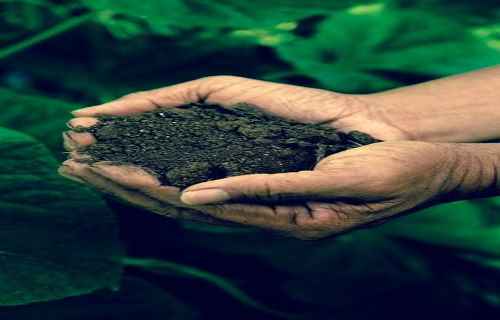
Fulvic Acid is the most miraculous healer on the face of the earth.
You haven’t heard about it because doctors, hospitals, and drug companies have suppressed it.
It has long been Mother Nature’s best kept secret but it was only a secret because it was suppressed.
It probably will change your health no matter what condition your health is in right now.
There is one source far, far superior than any other.
What exactly is this substance, and what exactly does it cure?
FULVIC ACID is a HUMIC substance.
Fulvic Acid is the most highly refined water soluble substance on Earth.
Fulvic Acid is produced by the action of billions upon billions of microscopic plants, refining and recycling all of the plant matter to ever exist on Mother Earth since the beginning of time.
Scientists have determined that it takes over 3 tons of fresh green plant matter for Mother Nature to produce just one quart of concentrated Fulvic Acid.
Fulvic Acid contains literally millions of kinds and combinations of naturally occurring plant defense mechanisms.
It is nature’s perfect healing substance.
Government studies show that substances in Fulvic Acid have the power of the antibiotics produced by the drug companies, yet there is little chance that disease pathogens will ever become resistant to this naturally occurring substance from mother nature.
Fulvic Acid from Mother Nature is likely the most important health and medical discovery ever in history.
Nearly every plant, animal, and human disease can in some way be linked to the deficiency of Fulvic Acid.
A well-documented scientific and medical research journal called HEALTH ALERT 2.000 identified Fulvic Acid as the missing link in our food chain.
It is seriously depleted from agricultural soils and almost completely lacking in the modern human diet.
It was not lacking many eons of time ago.
The Healing Potential of Fulvic Acid
Along with enhancing nutrient transport, fulvic acid’s fantastic healing potential is also related to its ability to:
Dissolve and remove accumulated toxic pollutants from the body
Act as powerful antioxidants, inactivating harmful free radicals
Increase the body’s overall “redox potential”
Enhance enzyme activity, including alkaline phosphatases (help to break down proteins), transaminases (needed to make proteins), and invertase (breaks down sugar into glucose and fructose)
For all these reasons, an increasing number of health experts are beginning to advocate that everyone take a fulvic acid supplement regularly – both to overcome any nutrient deficiencies they may have, and to better maintain their health and wellbeing.
What is Fulvic Acid?
Fulvic acid is extracted from humus – a thick, dark brown or black organic material that forms in the soil, sediment, or aquatic environments when plant and animal matter decays into its most basic chemical elements. Humus makes soil more fertile and also allows air and water to move easily through soil, allowing oxygen to reach the roots of plants.
Along with fulvic acid, humic acid is the other major component of humus. In fact, fulvic acid is actually a type of lightweight humic acid. Of the two, fulvic acid is used for its many nutritional benefits, while non-fulvic humic acid is better known for its antiviral and antibacterial properties.
Many of the chemicals that are naturally present in fulvic acid are important (even critical) nutrients for plants, bacteria, and other organisms that live in soil. Soil containing humus and fulvic acid is better able to retain moisture. They also improve soil structure and enable plants to easily take up and use the vital nutrients they need.
I would recommendthis programit works well and helps people with type 1 and type 2 diabetes. This program also requires work and has to be followed exactly to the point to be effective. However users who are not satisfied with their results or with the program overall can ask for a full refund anytime within a 60-day money-back
Fulvic Acid, the Super Antioxidant
In combination with active carbon and high molecular oxygen, fulvic acid is one of the most powerful antioxidants around. When it encounters free radicals, it supplies an equal and opposite charge to neutralize them, acting as a health-protective antioxidant.
By being an electron donor as well an electron acceptor, based on the cell’s requirements, fulvic acid protects our body’s cells and their internal structures from harmful oxidation by environmental toxins and pollutants – and is therefore a crucial factor in the prevention, even reversal of infections and diseases.

Treating Cancer with Fulvic
Cancer is the second leading cause of death in the United States. However, advances in scientific research indicate that natural substances – including Humic & Fulvic Acid – can help arrest cancer growth.
At this point, according to medical studies, the beneficial effects of Fulvic Acid in cancer treatment appear to be two-fold. Fulvic Acid is both a “super antioxidant” that stimulates the body’s own immune system, and acts as a cancer growth inhibitor.
Fulvic Acid Stimulates the Immune System to Fight Cancer
Traditional approaches to cancer – including radiation and chemotherapy – utilize dangerous toxins to kill cancer cells. And these treatments often have painful and dangerous side-effects.
Modern cancer treatments now attempt to harness the body’s own immune system to eliminate the cancer, or at least slow its growth and stunt its ability to spread. Research into this approach – called immunotherapy – has shown improved survival rates for some cancers, including kidney and lung cancer.
Recent scientific studies have shown that antioxidants are beneficial in immunotherapy for cancer treatment and prevention. And, Humates, including Humic & Fulvic Acid, are nature’s most powerful antioxidants.
Medical studies have shown that “super antioxidants” work by obstructing the “signaling protein pathways” that allow certain cancers to spread. This prevents the cancer from reproducing itself and spreading cancerous DNA and RNA from the host cell to other cells. Put simply, antioxidants block the signals that enable cancer to spread to adjacent cells – effectively neutralizing the spread of cancer.
Scientific Research on Fulvic Acid for Cancer
In clinical tests humic acid was proven to have therapeutic effects on cervical cancer.
Humic and Fulvic Acid have also been scientifically demonstrated to inhibit growth of leukemia HL-60 cells.
When treated for two years with a humic extract, patients with esophageal tumors experienced a 100% success rate in preventing tumor progression into the cancerous state.
Hospital studies on thyroid tumors, some cancerous, showed that injections with humic extract resulted in 90% success in stopping tumor growth and diminishing size of tumors – and an 80% rate of complete cure.
Nuzum – a foremost authority on Fulvic Acid – has successfully treated over 8,000 patients with Fulvic acid – with no negative side effects were ever reported.
How Humate Derived Fulvic Acid Supplements Fights Cancer
New developments in cancer research have found that cancerous cells themselves cause an overproduction of free-radicals – which accounts for cancer’s typical runaway cell growth. The free radicals bombard the surrounding cells, damaging them. And the cancer cells produce “oxidants” that act as messenger molecules – sending signals through protein pathways to surrounding cells.
Worldwide pharmacological studies have shown that various mechanisms within the humic molecule’s structure make it a free radical acceptor, scavenger and antioxidant. It works to obstruct the signaling protein pathways, neutralizing the spread of the cancer.
While humic extracts – including Humic & Fulvic Acid supplements – do not always destroy cancer cells, they have been scientifically proven to generally halt their growth and spread. In many studies, in fact, tumors disappeared spontaneously almost immediately.
Fulvic Acid Supplements for Cancer
Scientific studies have proven that the higher the quality of humic extract, the better the ability to reverse cancer. Chemist’s tests have shown that the Humate from which Nature’s Fulvic Supplements are made is the highest grade of organic Humate available, rich in natural minerals and micronutrients.
Nature’s Fulvic unique Humate material originated from prehistoric-era lush, nutrient-rich vegetation – composted over millions of years – to form the purest form of concentrated, organic Humate – rich in Humic & Fulvic acid, enzymes and minerals. And since Fulvic Acid supplements are made from 100% natural plant-based sources, they should not interfere with any necessary thyroid drugs.
Fulvic acid is an organic product and known to be completely non-toxic. However, it should be remembered that reports of their effectiveness are anecdotal at this time.
Therefore, always be sure to consult a qualified healthcare practitioner before taking fulvic acid supplements to ensure that they don’t interfere with any other ongoing treatments or medications.
Finally, remember that no supplement can substitute for a balanced, nutritious diet, proper exercise, and healthy lifestyle choices. On the other hand, taking a fulvic acid supplement regularly will perfectly complement your healthy life choices – aiding in overall health, wellbeing, and protection from disease.
Herbs and other naturalremedies can be as effective as traditional treatments, often without the same negative side effects,” says Roberta Lee, MD, medical director of the Continuum Center for Health and Healing at Beth Israel Medical Center in New York City.Here are 10 super healersyou’ll want to add to the all-natural section of your medicine cabinet—and even to your favorite recipes. Folding one or two of them into your cooking every day can yield big benefits.
Do plants repair themselves?
What plant can cure cancer?
What are some herbs for healing?
What plants can be used as medicine?
What herbs are good for healing wounds?

The Home Doctor
Do you know about the gift of nature to save the life of people from various health problems and make them feel secure by curing significant issues? How to live healthy in this world without having chronic diseases or illness or any other health issues which may hurt you physically and mentally? Due to dense population, people are trying to demolish the forest, garden areas to create shelter, so they forced to destroy the nature’s gift such as natural ingredients, secret medicinal herbs and more which are grown in wild forest, mountains and other places. When you read this review entirely, sure you will get chance to know about secrets medicinal ingredients, herbs and more used by our ancestor to get back the lost health without losing your life. Claude Davis was highlighted all the stuff in the form of the e-book The Home Doctor filled with a list of natural ingredients and remedies that you can quickly grow in the backyard or at free space to include it in your routine diet or external usage to get well soon.
Books can be your best pre-collapse investment.
Carnivore’s Bible (is a wellknown meat processor providing custom meat processing services locally andacross the state of Montana and more. Whether your needs are for domestic meator wild game meat processing)
The Lost Book of Remedies PDF ( contains a series of medicinal andherbal recipes to make home made remedies from medicinal plants and herbs.Chromic diseases and maladies can be overcome by taking the remediesoutlined in this book. The writer claims that his grandfather was taughtherbalism and healing whilst in active service during world war twoand that he has treated many soldiers with his home made cures. )
Easy Cellar(Info about building and managing your root cellar, plus printable plans. The book on building and using root cellars – The Complete Root Cellar Book.)
The Lost Ways (Learn the long forgotten secrets that helped our forefathers survive famines,wars,economic crisis and anything else life threw at them)
LOST WAYS 2 ( Wordof the day: Prepare! And do it the old fashion way, like our fore-fathers did it and succeed longbefore us,because what lies ahead of us will require all the help we can get. Watch this video and learn the 3 skills that ensured our ancestors survival in hard times offamine and war.)
Treating Cancer With Fulvic Acid - The Unexplored Health Benefits of Fulvic Acid - PrepperFortressIf you're gonna fight, fight like you're the third monkey on the ramp to Noah's Ark... and brother its starting to rain. Join our efforts to Secure America's Borders and End Illegal Immigration by Joining ALIPAC's E-Mail Alerts network (CLICK HERE)
-
07-10-2023, 01:55 PM #7804
Want to Avoid Typhus? Do Your Laundry…..
undergraundmedic.com June 7, 2023 No Commentson Want to Avoid Typhus? Do Your Laundry…..

Pediculus humanusFirst of all typhus should not be confused with typhoid, they are two entirely different things. Also, there are quite a few types of typhus in circulation, this article deals with the most serious, epidemic typhus which is spread by the body louse – Pediculus corporis. (Pediculus Humanus)
This little louse is closely related to the head lice- Pediculus capitus but unlike its cousin it lives in clothing and moves onto the human to feed, returning to clothing after feeding. It is also different in that it can spread bacterial infection which the head louse cannot.
The body louse seems to appear out of nowhere in troubled times, wars, economic crises, any situation that causes a return to the unsanitary conditions of yesteryear. Scientists have tried for years to find out how they suddenly appear during hard times, what can cause such a huge surge in these tiny six-legged critters that an epidemic is the result, well now they know. They are here all the time.
History books will tell you all about typhus epidemics, how tens of thousands of soldiers died in 1812, how millions have died across the globe from sporadic outbreaks of this disease. Yet even having said that typhus infections dropped well before the introduction of the only known treatment, antibiotics. This drop correlates exactly with an increase in public health legislation, improvement in housing and the introduction of running water in cities.
There are few cases of typhus recorded each year in the developed world. The United States sees no more than a couple of hundred cases a year, mostly amongst the long-term homeless who have not got the facilities to maintain a high level of cleanliness, in particular regarding their clothes.
As the economic situation worsens and more and more people become homeless it is not unrealistic to assume that we will get to a point where typhus once again starts to make its presence felt. If you extend this line of thinking to those who have no connection to mains water supply due to unpaid bills, the scenario gets worse still. If you move on from that to a societal breakdown, where nobody has water to spare for laundering clothes you have the stage set for a return of typhus at epidemic levels. You must also factor in, that in a full breakdown treatment for the disease will not be available.
The bite of the body louse in itself does not cause typhus. It is the excrement that causes the problem. This is deposited on the skin as the louse feeds. A short while after the louse returns to its home in your clothing you start to itch at the feed site. When you scratch you transfer the droppings that are now on your finger tips and under your nails into the open feed site and thus allow the bacteria entry into your system.

What is typhus?
It’s an infection caused by the faeces of the body louse, Pediculus corporis.The bacterium that causes the disease is Rickettsiae prowazekii. The bacteria invades the endothelial cells of blood vessels causing multi-system vasculitis.
Where does it strike?
Outbreaks will occur where poverty, homelessness, close human contact and lack of washing and laundry facilities co-exist. Some of the recent outbreaks occurred in Peru, Burundi and Russia.
- ComplicationsSymptoms of typhus
- General malaise
- Abrupt onset severe headache
- Fever
- Myalgia (muscle pain)
- Blanching rash turning to unblanching rash within 2days. It will not be present on the palms of the hands, soles of the feet,or face.
- Cough/wheeze
- Abdominal pain
- Nausea
- Organ damage
- Hypovolaemia (decrease in circulating blood volume)
- Electrolyte Imbalance
- Gangrene
- Secondary infection such as pneumonia
- Reactivation as the infection stays for life though the patient will be asymptomatic after treatment.

Treatment
Doxycycline or tetracycline is the current treatment of choice though chloramphenicol has had a good success rate. Penicillin based drugs can be used but there has been issues regarding resistance of the bacterium to these drugs.
SEE NOTE BELOW REGARDING STORAGE OF CYCLINE DRUGS
Many labs tests are required to confirm the diagnosis but antibiotics will be started without waiting for the results of the tests if typhus is suspected.
Prevention
Infested clothing should be exposed to water of 158*F (70*C) for a minimum of an hour. A washing machine cycle is preferable.
Where water and or fuel is in short supply insecticide may be used to kill the lice.0.5% Permethrin is recommended.
Avoid unsanitary and overcrowded places
If you cannot accomplish any of the above preventative measures leave worn clothing in a ‘hard’ environment, such as a bucket for 7 days. The lice can survive no longer that 5 days without food. Infested or possibly infested clothes should be kept away from other clothing.
Rotate worn clothing leaving it 7 days before wearing it again. This will ensure if you have picked up a louse from somewhere it will be dead before you wear the clothes again.
Change your clothes as soon as possible after being in a ‘louse likely’ situation.
Apply bite treatment before you scratch, if you can avoid scratching until you have washed/wiped the whole area around the itch you may avoid transferring the bacterium to the bite site. You cannot distinguish one bite from another so avoiding scratching is a sensible precaution. Wipe the area around the bite carefully, do not go back and forth across the bite until you have cleaned the area around it thoroughly.
If you have water to wash clothes, but cannot maintain the high temperature, leave the clothes unworn for 7 days and then wash them, bashing them as you do so. The reason you see women bashing clothes off rocks is not always to keep their whites dazzling. Bashing the clothes dislodges the lice.
The lice prefer nooks and crannies and like seams, hems and pocket linings to hide in so turning clothes inside out makes them easier to dislodge.
NOTE ABOUT DEOXYCYCLINE AND TETRACYCLINE
These antibiotics should NOT be stored for long term use. Be guided by the expiry date on the box. These drugs become toxic as you move past the expiry date. They become more toxic the further past the expiry date you go. Taking these drugs when they are out of date is highly dangerous and depending on the age of the drug can lead to death.
Typhus is not a disease to take lightly.It is only sanitation, our understanding of the importance of hygiene and prompt action by doctors that prevent typhus epidemics claiming the hundreds of thousands of victims a year that we read about in the history books. If for reasons beyond our control we are no longer able to launder clothes effectively, and those people who are currently treated for typhus are no longer able to access medical help it is highly likely that epidemic typhus will once again claim lives on the scale it has thoughout history.
Take care
- Medicinal Garden
- With your seeds kit, you’ll also receive a FREE Medicinal Guide that shows you how to turn these 10 plants into tinctures, ointments, salves, poultices, decoctions, infusions, essential oils —all in minute detail so you can follow our guide even if you’ve never made an herbal medicine in your life.

Books can be your best pre-collapse investment.
Carnivore’s Bible (is a wellknown meat processor providing custom meat processing services locally andacross the state of Montana and more. Whether your needs are for domestic meator wild game meat processing)
The Lost Book of Remedies PDF ( contains a series of medicinal andherbal recipes to make home made remedies from medicinal plants and herbs.Chromic diseases and maladies can be overcome by taking the remediesoutlined in this book. The writer claims that his grandfather was taughtherbalism and healing whilst in active service during world war twoand that he has treated many soldiers with his home made cures. )
Easy Cellar(Info about building and managing your root cellar, plus printable plans. The book on building and using root cellars – The Complete Root Cellar Book.)
The Lost Ways (Learn the long forgotten secrets that helped our forefathers survive famines,wars,economic crisis and anything else life threw at them)
LOST WAYS 2 ( Wordof the day: Prepare! And do it the old fashion way, like our fore-fathers did it and succeed longbefore us,because what lies ahead of us will require all the help we can get. Watch this video and learn the 3 skills that ensured our ancestors survival in hard times offamine and war.)
Want to Avoid Typhus? Do Your Laundry….. - PrepperFortress
If you're gonna fight, fight like you're the third monkey on the ramp to Noah's Ark... and brother its starting to rain. Join our efforts to Secure America's Borders and End Illegal Immigration by Joining ALIPAC's E-Mail Alerts network (CLICK HERE)
-
07-10-2023, 02:07 PM #7805
Plants That Keep Mosquitoes and Flies Away
Amy S. June 6, 2023 No Commentson Plants That Keep Mosquitoes and Flies Away

Many herbaceous plants have the fantastic ability to repel troublesome bugs, fungi, and other vectors of pathogens. They usually contain a complex set of phytochemicals that make them fatally toxic to these pests when ingested or upon physical contact. These compounds may also collectively emit an uninviting and practically offensive scent to them, effectively forcing them to stay as far away from the plant as possible.
Beneficial greens often come in the form of what we perceive as attractive and pleasantly aromatic houseplants. Their natural undesirability to pests is just one of their many appealing features. As they ward off filthy insects like flies and fungus gnats, they add color, texture, structure, and fragrance to the home. Moreover, many of them have a wealth of uses in the kitchen!
During warm or damp periods of the year, when flies are most likely to successfully breed and hatch, it may be necessary to decorate entry points of the home with fly-repellent plants. Though they are not fool-proof solutions to serious infestations, which usually occur when trash is left to fester, they should at least dissuade some curious flies from freely entering your household. For increased effectiveness, grow these species in large quantities.
1) Lemongrass (Cymbopogon citratus)
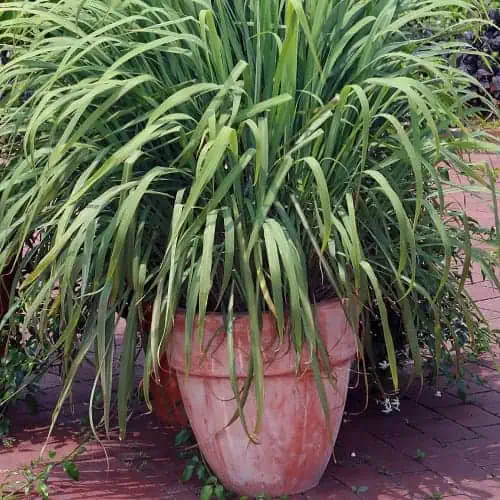 Native to Southeast Asia
Native to Southeast Asia
A true member of the grass family (Poaceae), lemongrass is a tropical plant with medicinal, culinary, and ornamental uses. It is named for the lemon-like scent emitted by its lengthy leaf blades, which are bluish-green and have parallel veins. The leaves of fully-grown specimens gracefully arch over and emit a fragrance that is strong enough to repel both flies and mosquitoes.
In temperate zones, this tropical plant is best raised in indoor or protected locations as it is not hardy to cool temperatures and frost. Small specimens can be maintained on windowsills receiving at least 6 – 8 hours of direct sunlight per day. Healthy plants produce a cocktail of beneficial compounds with pharmacological properties. Their essential oils can be used as a natural antioxidant and insect repellent.
The fly-repellent properties of C. citratus oils have been formally documented. When applied to materials with substances that are known for attracting flies (e.g. blood), lemongrass oil can serve as a repellent barrier against stable flies (Stomoxys calcitrans) and houseflies (Muscidae). The essential oil contains geraniol and citronellol, which are both known for their repellent properties.
2) Lavender (Lavandula spp.)
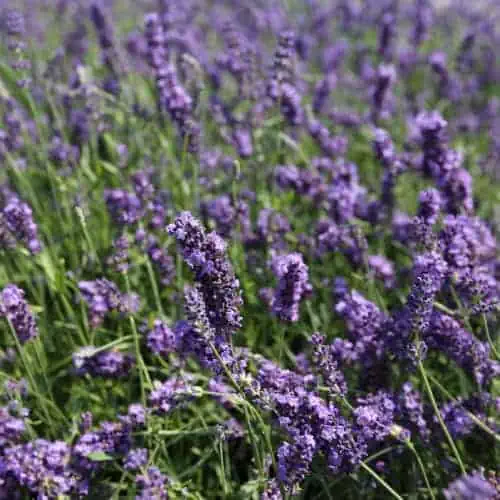 Native to Europe, East Africa, and Southwest Asia
Native to Europe, East Africa, and Southwest Asia
Lavender oils are known for inducing a state of tranquility in us humans, lulling both adults and children to a restful slumber. The oils are unique culinary ingredients with notably strong flavors. Cultivated in many parts of the world, lavender plants have enormous benefits due to the phytochemicals in these lipids. Apart from having uses in herbalism, they also have natural insecticidal properties.
Great for adding color to sprawling gardens and fields, many Lavandula species can be grown in the home. To use them as a repellent, place healthy specimens close to key entry points and around the kitchen, where the smell of food may attract flies. To release more of their heady fragrance, it may be necessary to regularly snip some leaves or wound the plant. For this reason, some people opt to go the more practical route by using the extracted oils and a diffuser.
If your indoor spaces receive minimal sun exposure, it may be wiser to use lavender-scented products instead of growing lavender as a houseplant. Candles, soaps, and dried leaves in pouches are great for emitting a fragrance that wafts through poorly lit rooms. You may also grow lavender as a border plant outdoors, taking care to place its stands close to windows that are regularly opened.

3) Venus flytrap (Dionaea muscipula)
 Native to the eastern US
Native to the eastern US
The venus flytrap doesn’t exactly repel flies in a conventional way; instead, it has a more indirect manner of keeping pesky flies away from key points of the home. It has evolved to attract, instead of deter, these very insects. Perhaps the most popular of all carnivorous plants, it can aid in eliminating indoor fly populations by feeding on them.
Flies often find themselves in the “jaws” of the specialized, hinged leaves, unable to wriggle away and escape to safety. These leaves contain sensitive trichomes that, when touched, cause both lobes to forcefully snap shut. The flies are then digested via the activation of enzymes that can break down their exoskeletons. Depending on the size of the fly and the maturity of the plant, the whole process takes about 3 – 5 days.
Apart from being a functional plant in the home, the venus flytrap makes for a great ornamental because of its unusual features. Endlessly fascinating to watch despite its miniature size, it can serve as an educational plant for both adults and young children. To expose it to as many flies as possible, place it in well-lit entranceways and on windowsills.
4) Basil (Ocimum basilicum)
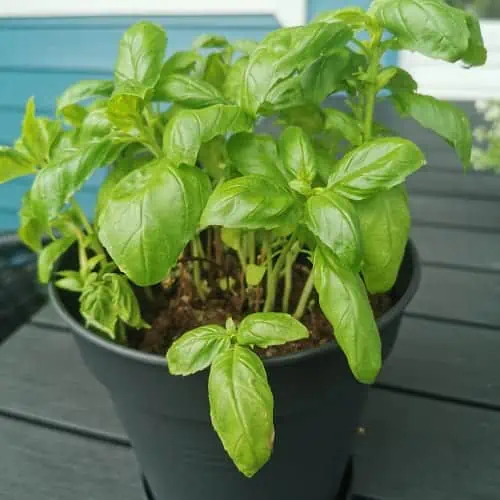 Native to tropical Asia and Africa
Native to tropical Asia and Africa
One of the most popularly used culinary herbs due to its citrus-like taste, basil is an incredibly useful annual to have in both indoor locations and outdoor gardens. Mechanical damage to its nutritious leaves releases a strong fragrance. Though the smell may appeal to humans, it is practically repulsive to flies, mosquitoes, fleas, and many more troublesome insects.
This herb’s fragrance and delectable flavor are produced by its essential oil. Packed with aromatic compounds, the oil has insecticidal, fungicidal, and nematocidal properties. To flies, the smell of basil is pungent and unbearable. It also signifies the presence of toxic compounds that could potentially harm them. For this reason, basil is frequently planted as a natural repellent around vegetable beds.
To maximize the functional uses of basil in indoor locations, make sure to grow this herb in a brightly lit area with filtered sun exposure and ample ventilation. As fully intact plants may not be highly effective at warding off flies in their vicinity, you should occasionally prune the leaves to expose the internal oils. Don’t make the flavorful leaves go to waste, of course. Chop them up or add them to your dishes whole for flavor and color!
5) Peppermint (Mentha x piperita)
 Native to the Middle East and Europe
Native to the Middle East and Europe
The most popularly cultivated type of mint is Mentha x piperita, a hybrid between two vigorous species. Commonly known as peppermint, this plant naturally occurs in the wild wherever dense stands of both parent species are found. An herbaceous perennial, it can grow to about 35 inches (89 cm) tall. As this hybrid is unable to produce seeds on its own, its vegetative spread is facilitated by rapidly-growing runners.
Peppermint can be cultivated in indoor containers because it thrives best in locations with partial to dappled sun exposure. Regularly moistened soil and the availability of ample nutrients leads to favorable growth rates. Once the plant begins to produce blooms, its leaves are usually ready for harvesting. When these are plucked off the main shoot, they release a distinctly minty aroma.
The fragrance of peppermint oils, like that of basil, is detestable to small flies and many other winged insects. It mainly contains pulegone and menthone, compounds with natural pesticidal properties. These ketone monoterpenes are toxic to insects and can disrupt the normal functions of their neuronal pathways.
6) Catnip (Nepeta cataria)
 Native to Europe and Asia
Native to Europe and Asia
A fragrant herb that elicits bizarre behavior in some cats, N. cataria is valued by herbalists for the relaxant properties of its essential oil. It is thus often added to tea infusions that are intended for use as natural sedatives. Apart from being a source of valuable oils, it is widely cultivated as an ornamental plant. Though this herb’s fragrance tends to repel houseflies and stable flies, its blooms attract pollinators and beneficial insects (e.g. butterflies and lacewings).
The main component of catnip oil is a terpenoid called nepetalactone. As a natural fly repellent, nepetalactone has been shown to be remarkably effective. Its deterrent effects rival or surmount those of DEET, which is a common ingredient in artificially-formulated repellents. Catnip oil has shown potential as a substitute for industrial insecticides in pastures and feedlots where insects often attack livestock.
To grow catnip indoors, make sure its pot is situated in an area that receives bright light for at least 6 hours a day. Light is crucial for its normal growth and the production of its essential oil. Catnip should be rooted in a well-draining substrate and in a porous pot with drainage holes. Regular fertilization and pruning should keep its shoots and roots in good condition.

7) Sage (Salvia officinalis)
 Native to the Mediterranean
Native to the Mediterranean
An ornamental plant, source of fragrant essential oils, and a fantastic culinary ingredient and garnish for European dishes, sage is undoubtedly a valuable herb. Distinguished by its grayish-green, fuzzy leaves, it grows to about 2 feet (61 cm) tall. In late spring to summer, it produces lavender to pink inflorescences. Flower and leaf color may vary as this species comes in dozens of highly-prized cultivars.
The strong aroma of sage, which is released when its leaves and shoot are cut or charred, is traditionally believed to ward off evil. The jury’s out on whether it can truly repel troublesome spirits, but it can, indeed, keep unwanted insects away from the hearth and the home! Freshly cut sprigs of the plant should be placed in various locations to expand the reach of its scent.
Apart from repelling flies, ticks, and mosquitoes, the fragrance of sage can supposedly act as a mood booster! That alone is a compelling argument for growing this attractive herb indoors. Relatively drought-tolerant, sage makes for a low-maintenance houseplant. To keep its leaves in good condition, simply make sure that they are exposed to medium to full sun.
 Lemon balm (Melissa officinalis)
Lemon balm (Melissa officinalis)
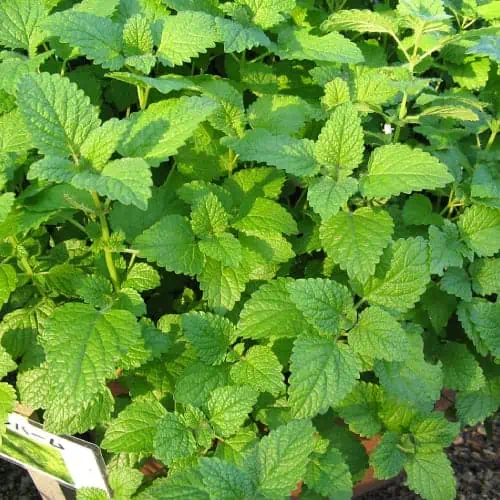 Native to the Mediterranean and Central Asia
Native to the Mediterranean and Central Asia
Another strongly-scented member of the mint family (Lamiaceae), lemon balm is an herbaceous perennial with many natural and herbal uses. It is deliberately cultivated as a source of ingredients for medicinal teas and as a flowering plant to attract honey bees. Its small, white blooms, which appear in summer, are rich in nectar whereas its leaves are rich in its lemon-scented essential oil.
Lemon balm oil contains many insecticidal and acaricidal compounds. Those which specifically repel flies include citronellal, linalool, neral, and geraniol. The predominance of these components is largely determined by the strain of M. officinalis and the conditions in which it is grown. Thus, the extracted oils of the plant are often mixed with those of citronella and lemon to increase their potency.
Lemon balm is fairly straightforward to grow indoors. All it requires is a pot of pathogen-free, well-draining soil. To prevent the soil from collecting too much water, make sure the pot has drainage holes. Leaf production should be accelerated by exposure to at least 5 – 6 hours of sun per day. Compared to other fragrant herbs, this plant is more likely to thrive in partly shaded conditions.
9) Marigold (Tagetes spp.)
 Native to the southwestern US, Central America, and South America
Native to the southwestern US, Central America, and South America
The leaves of most marigold species are known for their somewhat pungent and heavy scent. This fragrance, when emitted by large stands, can keep dozens of insects and nematodes away from the garden.
Among the more common marigolds, the French marigold (T. patula) and African marigold (T. erecta) have shown the most potential when it comes to their insect-repellent properties. This is largely due to their thiophenes, which are sulfur-containing compounds. Thiophenes repel not only flies but also aphids, maggots, and many other destructive insects.
Interestingly, though marigolds tend to repel unwanted pests, their blooms can attract beneficial insects, including beneficial flies (e.g. hover flies). Of course, they are less likely to attract insects at all if they are kept indoors. To ensure that they are healthy enough to produce stunning blooms and new foliage, keep their substrate regularly moistened yet well-ventilated. Keep marigolds close to a south-facing window that receives about 6 hours of direct sun per day.
10) Rosemary (Salvia rosmarinus)
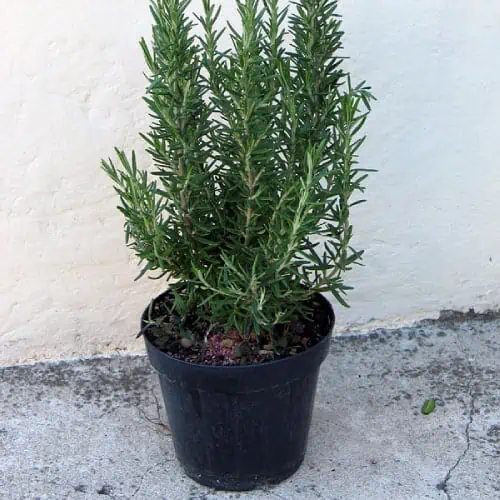 Native to the Mediterranean
Native to the Mediterranean
Troublesome flies and many other pests generally keep away from areas with dense stands of rosemary. Though this evergreen species is often known as an herb, it can exhibit upright, shrub-like growth as its older stems become increasingly woody. The stiff, needle-like leaves are rarely browsed by herbivorous animals, which may be sensitive to their bitter flavor and strong scent.
Several rosemary cultivars have received the RHS Award of Garden Merit due to their ease of care, attractive features, and general usefulness in the garden. When situated indoors, these plants can be grown as hardy miniatures. To maximize their effectiveness against flies, you may opt to collect some of the leaves and shoots and spread them around the home. The exposed tissues, which emit more of the essential oil, should produce a more concentrated scent.
To retain the healthy condition of rosemary cuttings once they are propagated indoors, make sure to gradually acclimate them to the reduced light intensity. With tough shoots that can persist through winter, rosemary should be watered only when the topsoil has dried out. With consistent ventilation, the leaves are more likely to flourish and produce enough oils to deter hungry flies.
- Medicinal Garden
- With your seeds kit, you’ll also receive a FREE Medicinal Guide that shows you how to turn these 10 plants into tinctures, ointments, salves, poultices, decoctions, infusions, essential oils —all in minute detail so you can follow our guide even if you’ve never made an herbal medicine in your life.

Books can be your best pre-collapse investment.
Carnivore’s Bible (is a wellknown meat processor providing custom meat processing services locally andacross the state of Montana and more. Whether your needs are for domestic meator wild game meat processing)
The Lost Book of Remedies PDF ( contains a series of medicinal andherbal recipes to make home made remedies from medicinal plants and herbs.Chromic diseases and maladies can be overcome by taking the remediesoutlined in this book. The writer claims that his grandfather was taughtherbalism and healing whilst in active service during world war twoand that he has treated many soldiers with his home made cures. )
Easy Cellar(Info about building and managing your root cellar, plus printable plans. The book on building and using root cellars – The Complete Root Cellar Book.)
The Lost Ways (Learn the long forgotten secrets that helped our forefathers survive famines,wars,economic crisis and anything else life threw at them)
LOST WAYS 2 ( Wordof the day: Prepare! And do it the old fashion way, like our fore-fathers did it and succeed longbefore us,because what lies ahead of us will require all the help we can get. Watch this video and learn the 3 skills that ensured our ancestors survival in hard times offamine and war.)
Plants That Keep Mosquitoes and Flies Away - PrepperFortress
Last edited by Airbornesapper07; 10-21-2025 at 11:35 PM.
If you're gonna fight, fight like you're the third monkey on the ramp to Noah's Ark... and brother its starting to rain. Join our efforts to Secure America's Borders and End Illegal Immigration by Joining ALIPAC's E-Mail Alerts network (CLICK HERE)
-
07-10-2023, 02:09 PM #7806
28 Medicinal Herbs You Need to Have in Your Garden
Amy S. May 31, 2023 No Commentson 28 Medicinal Herbs You Need to Have in Your Garden
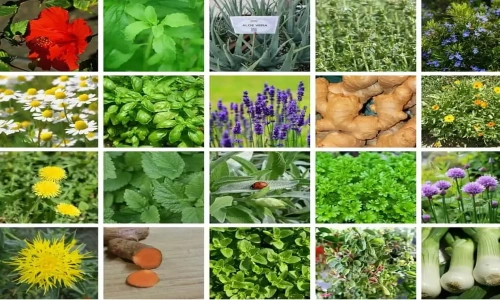
Herbs are the building blocks for tasty, delicious meals. Without them, food would be bland and unexciting. But have you considered all of the amazing health benefits you can get from consuming them? For centuries, people have turned to medicinal herbs to cure their ailments. Even though we may have chemical alternatives today, many of the most common garden greens have tried-and-true medical benefits.
From plants that cure headaches to ones that can calm nerves, herbs are a ready-made medicine cabinet that you can grow in the smallest space – even if you don’t have an outdoor garden. Check out our list of the most powerful herbs that will help keep you and your family healthy.
1. Oregano (Origanum vulgare)
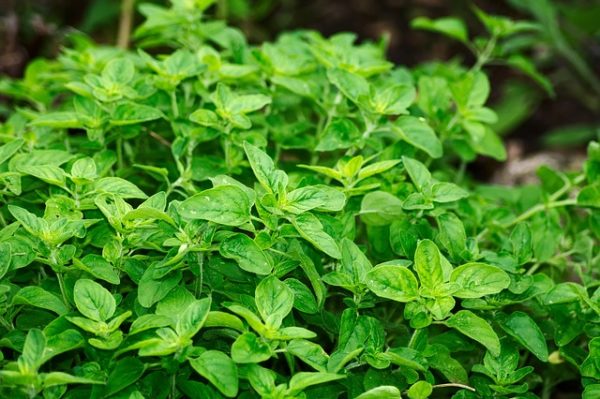
Culinary Use: Part of the mint family, this medicinal herb is available in multiple varieties. The tasty plant is used frequently in Italian and Greek dishes. It’s the classic addition to pasta or pizza sauce.
Medicinal Use: Oregano has antiseptic properties, and you can also use it to treat a number of stomach issues. Additionally, it’s an anti-inflammatory.
Little known fact: The name is derived from the Greek terms for mountain and joy, an apt description if we’ve ever heard one.
2. Chamomile (Matricaria chamomilla)
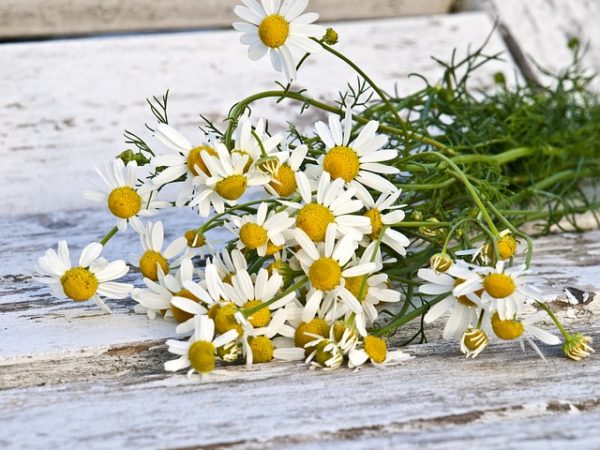
Culinary Use: This cheerful little herb is used most commonly for brewing herbal tea, but it also makes a sweet, floral addition to desserts and salads.
Medicinal Use: Like oregano, chamomile has anti-inflammatory properties. You can also take it in pill form or use it directly on the skin to treat a variety of ailments from eczema to stomach issues.
Little known fact: Using chamomile topically may induce skin reactions in some. We recommend doing a skin test before applying it to your skin.
3. Peppermint (Mentha × piperita)
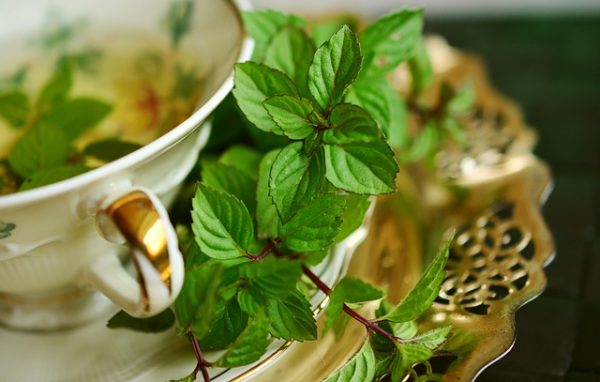
Culinary Use: Delicious in sweet and savory dishes, peppermint is a versatile medicinal herb in the mint family. It’s also easy to grow, and it packs a punch of flavor. Peppermint makes a delightful tea.
Medicinal Use: If you have a sore tummy, peppermint is your plant. I personally find peppermint essential oil to be helpful when I have a cold or a mild headache. There’s evidence that peppermint is just as effective as over the counter pain relief medication for treating certain types of headache pain.
Little known fact: Peppermint is a hybrid cross between watermint and spearmint.
- Medicinal Garden
- With your seeds kit, you’ll also receive a FREE Medicinal Guide that shows you how to turn these 10 plants into tinctures, ointments, salves, poultices, decoctions, infusions, essential oils —all in minute detail so you can follow our guide even if you’ve never made an herbal medicine in your life.
4. Bay Laurel (Laurus nobilis)
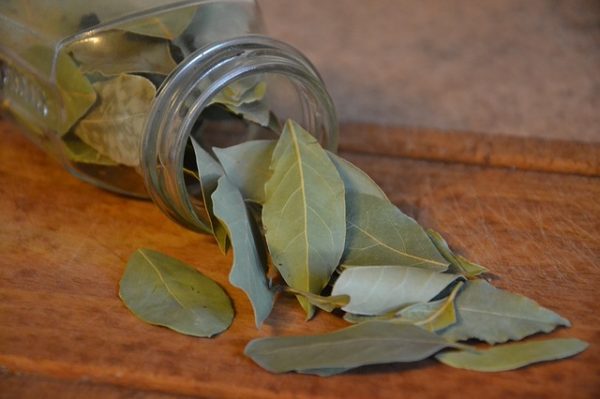
Culinary Use: A favorite herb for French cooking, bay leaf lends plenty of flavor to a variety of dishes. You may see this in dry leaf form, but it’s also marvelous fresh.
Medicinal Use: The bay laurel a useful and versatile medicinal herb for treating many ailments from joint pain to skin issues thanks to its anti-bacterial and anti-fungal properties.
Little known fact: Bay has sedative properties, and if you’re heading into surgery, steer clear of it.
5. Rosemary (Rosmarinus officinalis)
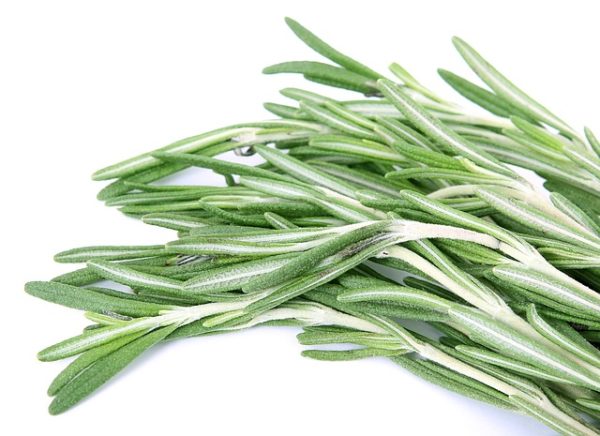
Culinary Use: Rosemary’s strong aroma and flavor make it a great accompaniment to meat dishes. It pairs well with pork, chicken, lamb or steak.
Medicinal Use: As an anti-microbial and anti-inflammatory medicinal herb it’s particularly useful when you apply it directly to the skin.
Little known fact: Some research suggests that rosemary may prevent neurological conditions affecting memory such as Alzheimer’s. Too bad I won’t reap the benefits, because it’s my least favorite herb!
6. Garlic (Allium sativum)
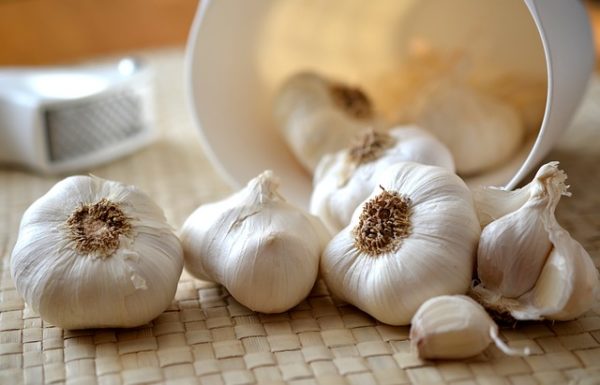
Culinary Use: The queen of savory dishes, garlic is a staple in most kitchens. There’s nothing quite like the sharp, spicy taste of it.
Medicinal Use: Consume garlic if you want to reap a slew of health benefits, including a boost to the immune system and help to regulate your bodily functions such as blood pressure.
Little known fact: Fermented garlic is what’s known as black garlic, and I believe it’s even more delicious than regular garlic!

7. Dill (Anethum graveolens)
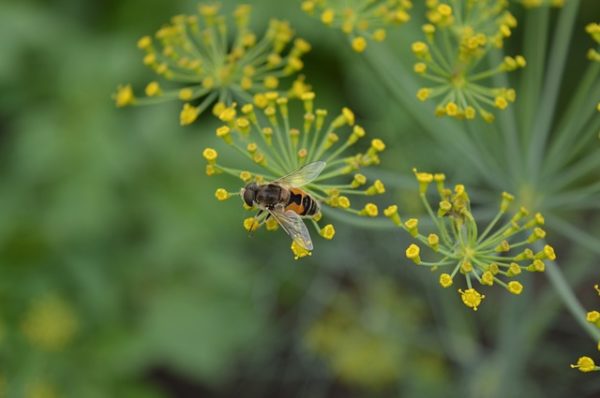
Culinary Use: This herb pairs exceptionally well with fish, and who hasn’t had a dill pickle.
Medicinal Use: You can use dill as a treatment for digestive issues.
Little known fact: Did you know that dill is actually related to the carrot family? It’s not surprising if you compare the feathery tops of both plants. They sure do look alike!
8. Savory (Satureja)
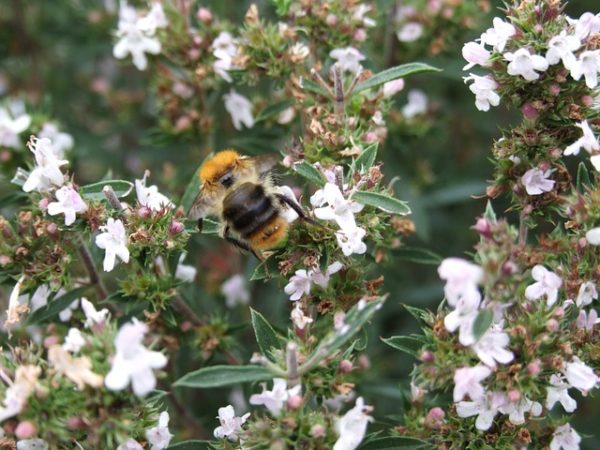
Culinary Use: A lesser known herb, you can use both savory’s winter and summer varieties in cooking. Its flavor is similar to thyme, though the taste differs depending on the variety.
Medicinal Use: You can use it to soothe the throat and treat other ailments concerning the digestive tract.
Little known fact: The winter variety of this herb was once thought to reduce libido.
9. Bergamot (Monarda fistulosa)
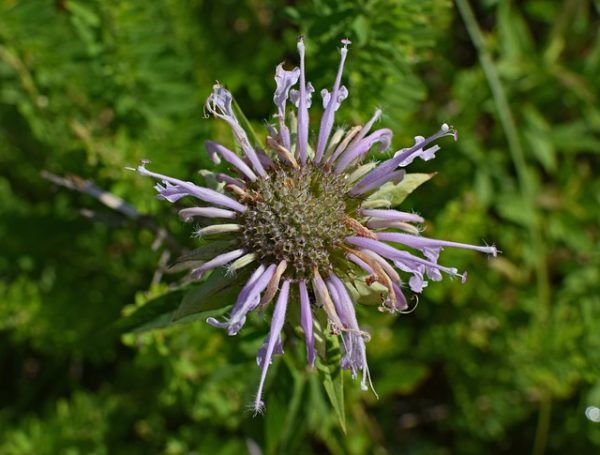
Culinary Use: You’ll often find this unusual little flower as an ingredient in tea. Bergamot has a faint citrus aroma, and you can eat the leaves and flowers of this perennial.
Medicinal Use: You can use bergamot as a treatment for headaches and upset stomach. Native Americans utilized it as a cure for the common cold.
Little known fact: Bergamot, also known as bee-balm, attracts not just bees but hummingbirds, too.
10. Thyme (Thymus vulgaris)
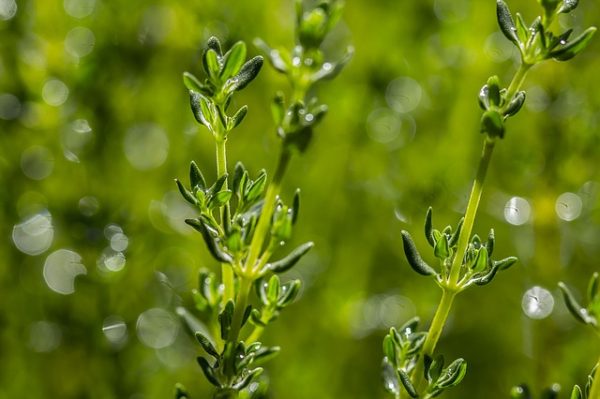
Culinary Use: Milder than other medicinal herbs, thyme still provides a lovely flavor to all sorts of dishes. Pairs easily with many foods and tastes superb fresh or dried.
Medicinal Use: This plant can ward off insects and has anti-bacterial properties.
Little known fact: Thyme was once used in place of modern embalming fluid.
11. Ginger (Zingiber officinale)
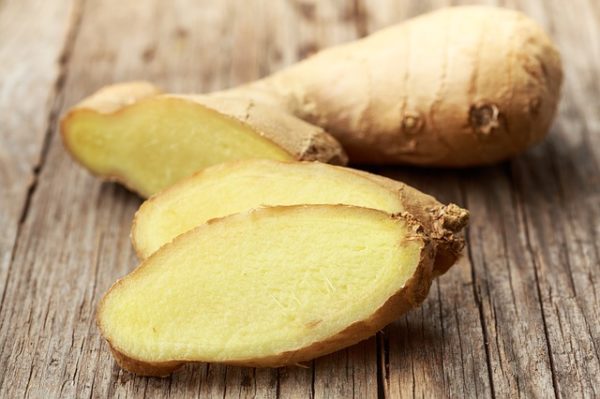
Culinary Use: Technically this is a spice rather than an herb, but it’s widely used in cooking worldwide. Ginger fresh or dried is delicious in a variety of cuisines from Indian to Thai.
Medicinal Use: Commonly used in Chinese herbal remedies, ginger can treat digestive ailments. It’s a miracle worker for nausea.
Little known fact: Ginger may interact with blood thinner medication.

12. Basil (Ocimum basilicum)
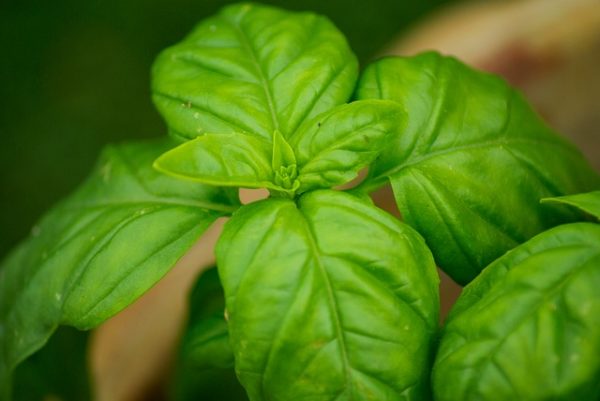
Culinary Use: Probably one of the most popular herbs out there. I often have friends asking me for advice on how to keep their basil alive. The Mediterranean herb is delicious made into pesto or as a fresh topping on pizza. There are many varieties of basil each with a unique flavor.
Medicinal Use: Though the evidence is limited, there’s some belief that basil is a helpful option for treating stomach issues.
Little known fact: Basil is nicknamed Saint Joseph’s Wort, not to be confused with Saint John’s Wort.
13. Lavender (Lavandula)
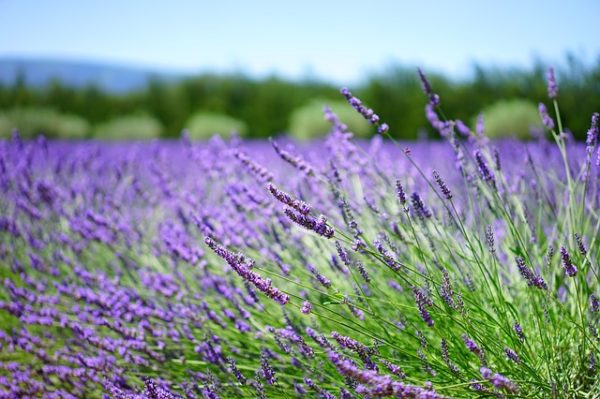
Culinary Use: Lavender isn’t just a pretty face. You might think it’s only useful for bouquets and adding fragrance to soaps and other bath products. Au contraire. You can also use lavender, of which there are more than 40 species, in the kitchen. Lavender adds a delicious flavor to honey, and you can also use it in flavoring desserts. Lavender tea is also popular.
Medicinal Use: This medicinal herb can be used as an antiseptic, and it’s also helpful in treating sleep problems.
Little known fact: In French, lavender is called lavendre, which is the verb for ‘to wash.’
14. Parsley (Petroselinum crispum)
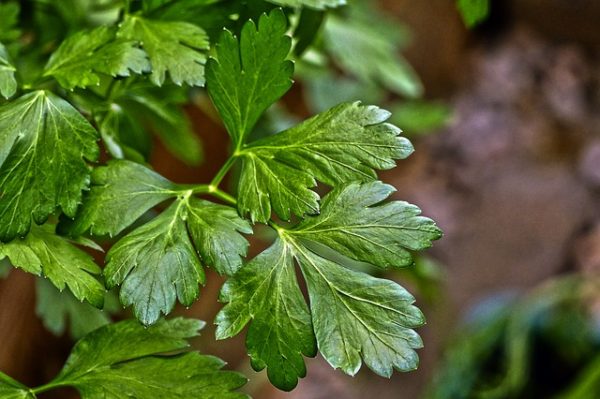
Culinary Use: Pretty much everyone has used curly or flat-leafed varieties of this herb as a garnish. But don’t just use parsley to top dishes. It has an intense, fresh taste that’s wonderful in spring soups.
Medicinal Use: There’s some evidence that this herb a diuretic. In the past, parsley was also used to treat conditions from skin lesions to cancer.
Little known fact: In large quantities, parsley is unsafe for pregnant women.
15. Sage (Salvia officinalis)
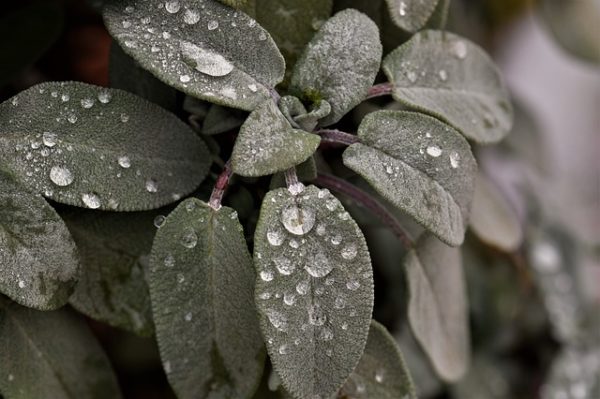
Culinary Use: Often used to flavor poultry dishes and as a garnish, this is a hardy perennial.
Medicinal Use: People use this medicinal herb as a useful remedy for a scratchy, tender throat.
Little known fact: Sage is also known as Salvia, but not all varieties are grown for culinary use. Dalmatian sage, also known as garden sage is the kind most often grown for kitchen harvests.
16. Fenugreek (Trigonella foenum-graecum)
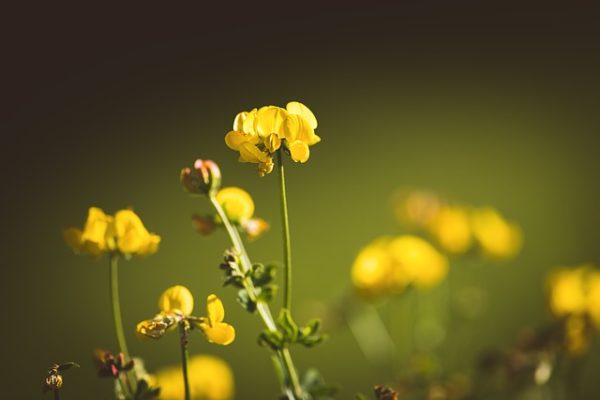
Culinary Use: I first heard about this plant when watching HBO’s drama ‘Six Feet Under.’ Chefs in the culinary world love to use it for its slightly bitter flavor.
Medicinal Use: Fenugreek shows promise in regulating blood sugar.
Little known fact: You can find this medicinal herb in imitation vanilla.
17. Borage (Borago officinalis)
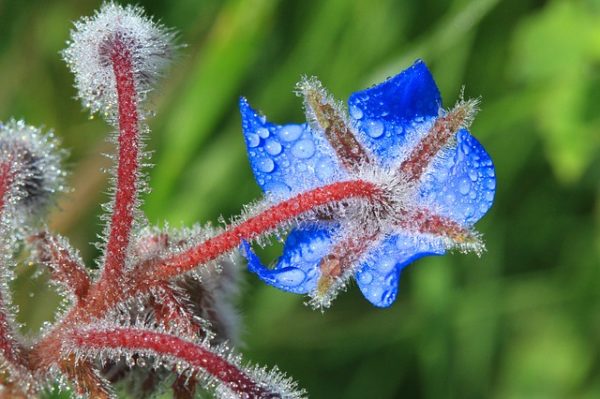
Culinary Use: It’s pretty flowers don’t just attract bees, they’re edible, too. The plant also makes a tasty tea.
Medicinal Use: There’s evidence that this medicinal herb can regulate cortisol levels in the body. When you apply it topically, it may help treat skin conditions.
Little known fact: Plant borage next to your brassicas to ward off the dreaded cabbage worm (my arch nemesis).
18. Fennel (Foeniculum vulgare)
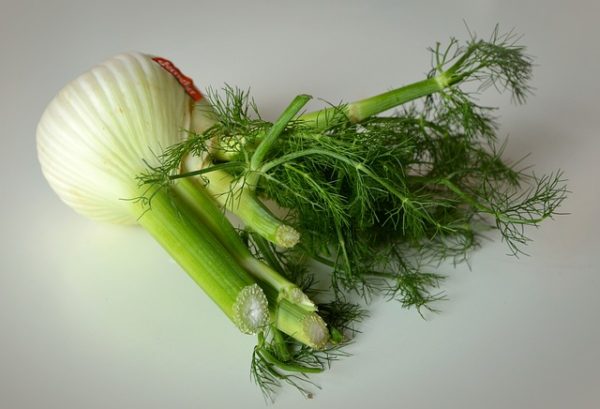

Culinary Use: Fennel tastes wonderful paired with fish. If you aren’t crazy about fennel’s anise-like flavor, you can mellow it out by cooking. For those of us who like the licorice punch, it makes a delicious addition to salads.
Medicinal Use: This highly nutritious plant provides myriad health benefits including regulation of blood pressure and improving digestion.
Little known fact: Fennel is an ingredient in some toothpaste.
19. Tarragon (Artemisia dracunculus)
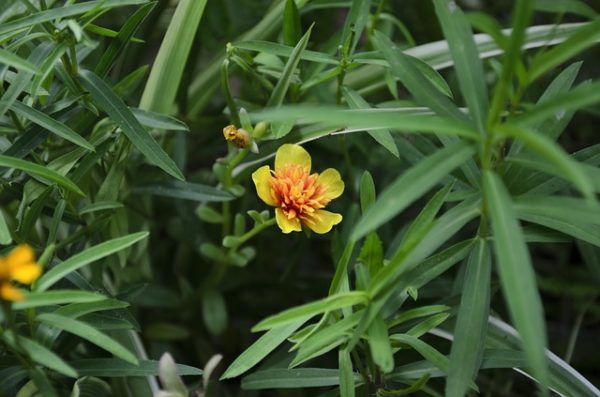
Culinary Use: The French variety is what you’ll find in the dried herb aisle at the grocery store and the kind you should grow in your kitchen garden. Other types are fine to eat but aren’t particularly tasty. It’s a versatile medicinal herb used in many kinds of dishes including sauces and regional beverages.
Medicinal Use: Tarragon can potentially stimulate appetite and treat problems with digestion, but there’s little evidence to support these claims.
Little known fact: This medicinal herb is a cousin of the majestic sunflower.
20. Echinacea (Echinacea purpurea)
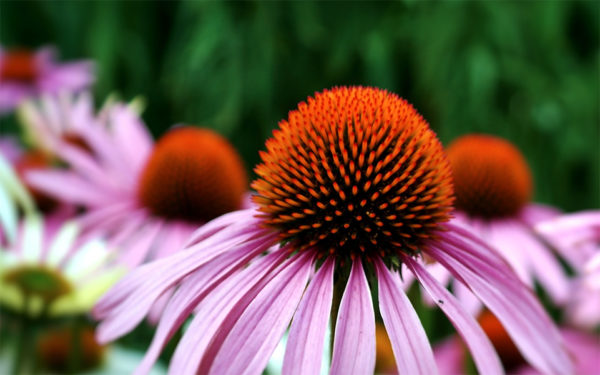
Culinary Use: None. It tastes sweet at first, but then turns bitter and make your tongue tingle.
Medicinal Use: You can use echinacea to reduce internal infections. An injection can help treat hemorrhoids, and you can also use it heal to clean sores and skin inflammation. Contrary to what you’ve probably heard, there isn’t much evidence to support taking echinacea to help with colds.
Little known fact: The name comes from the Greek term for a hedgehog, a reference to the prickly-looking flowers.
21. Feverfew (Tanacetum parthenium)
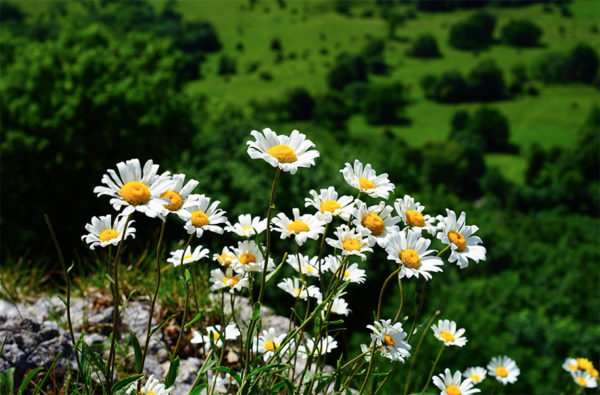
Culinary Use: None
Medicinal Use: Given the name, it shouldn’t surprise you that this plant is good for treating fevers. It can also help with migraines, inflammation, menstrual cramps and to relieve gas and bloating.
Little known fact: The oil contains a compound that can paralyze fleas.
22. Lemon Balm (Melissa officinalis)
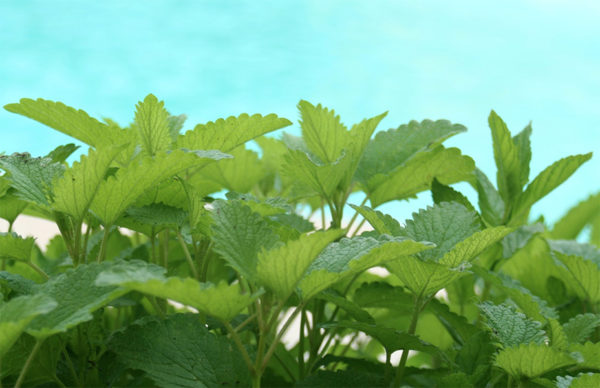
Culinary Use: Lemon balm can replace lemon peel in recipes or anywhere you want a hint of lemon flavor. It makes a lovely tea. You can add the leaves to a salad for a citrusy punch.
Medicinal Use: Lemon calm contains a calming agent, which can help ease anxiety and put you to sleep. There’s also some evidence that it can help regulate benign heart palpitations. An extract on the skin can help with cold sores.
Little known fact: The Latin name Melissa officinalis comes from the Greek nymph named Melissa who spread the word about the wonders of honey. Since honeybees love this plant, the name is fitting.
23. St. John’s Wort (Hypericum perforatum)
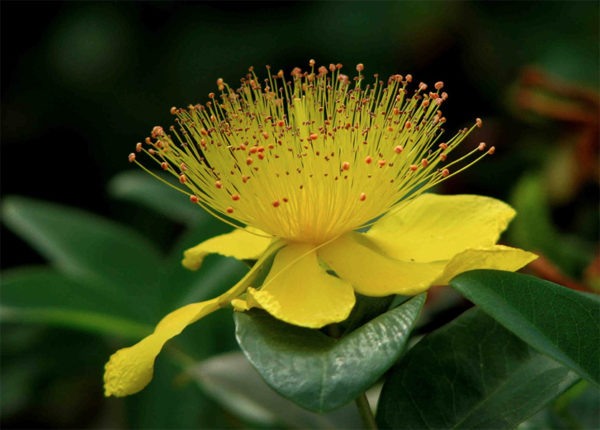
Culinary Use: None, though people used to drink it to ward off evil spirits.
Medicinal Use: St. John’s Wort has a reputation for helping with depressive disorders including bipolar disorder because it impacts serotonin levels. Be careful, though, because it can interact negatively with other meds and the science isn’t conclusive. It can also help with anemia, congestion and urinary issues.
Little known fact: The tea made from this plant smelled so foul that people assumed evil spirits wouldn’t bother someone who drank it.
24. Nettles ( Urtica dioica)
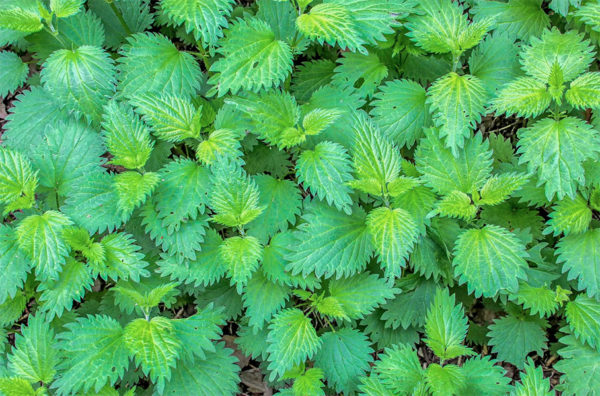
Culinary Use: Nettles are delicious in soups, salads, and pasta. It’s also marvelous on pizza or on a warm grain salad.
Medicinal Use: Nettles are a valuable addition to a medicinal herb garden. They help with anemia, gout, skin disorders, urinary issues, arthritis, joint pain, and kidney stones.
Little known fact: Scientists believe that nettles developed those awful stinging hairs to ward off grazing animals. It works on cows, but goats still nibble on the plants.

25. Burdock (Arctium)
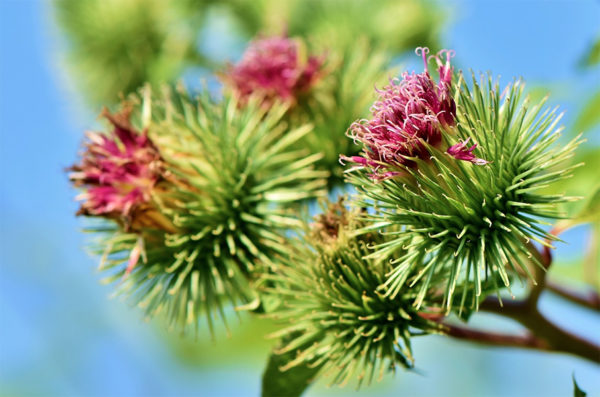
Culinary Use: While the leaves and flowers are useful in medicine, the culinary power of burdock lies in its roots. People in Japan know this plant as gobo. You’ll frequently see it along with sushi, but you can also eat it dried or pickled, too. You can add it to soups and stews as well.
Medicinal Use: Burdock does wonders for the skin. It helps treat eczema and psoriasis. Internally, it helps with a sore throat, colds, and tonsilitis. It’s also a diuretic.
Little known fact: Burdock was the inspiration for Velcro. The inventor was hiking with his dog and noticed how the burdock seeds locked onto his dog’s fur, and the rest is history.
26. Wormwood (Artemisia absinthium)
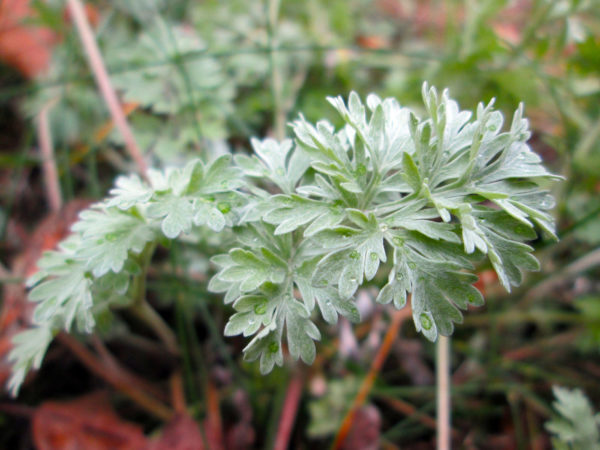
Culinary Use: Wormwood is most famous as an ingredient in absinthe, but you can find it in other liquors, bitters, wines, and flavorings.
Medicinal Use: You can use wormwood to help with stomach issues like nausea, loss of appetite and gallbladder disease. It can also help lower fevers and ease depression. You can apply it to the skin to heal wounds and insect bites.
Little known fact: Wormwood got its name from the goddess Artemis, who is the goddess of chastity and birth. In the past, people thought the herb could help promote chastity.
27. Motherwort (Leonurus cardiaca)
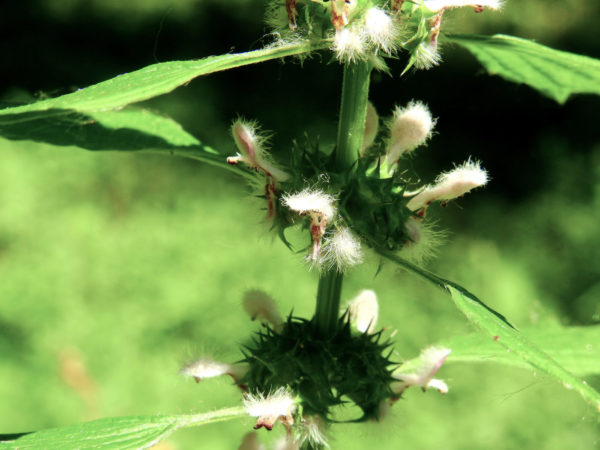
Culinary Use: Motherwort is a member of the mint family, but we don’t recommend using it in your cooking because it has a bitter taste.
Medicinal Use: You can use motherwort for cardiovascular issues like heart failure and irregular heartbeat. It also helps alleviate menstrual pain, can bring on menstruation, and eases symptoms of menopause. It’s an antioxidant.
Little known fact: Legend has that a town was built in a spot near a spring that bubbled up through motherwort plants. Allegedly, the people who lived in the city drank the spring water, and everyone lived over a century. That’s why we associate this medicinal herb with longevity today.
28. Catnip (Nepeta cataria)
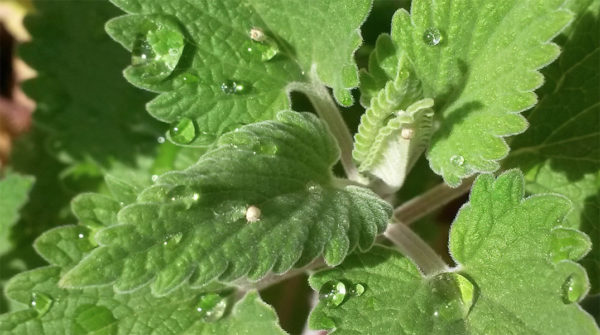
Culinary Use: Catnip is also part of the mint family. Beyond giving it to your cat, it is tasty in salads, soups, and sauces.
Medicinal Use: Catnip is good for relieving nerves and calming the stomach. You can also use it to ease painful menstrual cramps. There’s also evidence that it can help with headaches and fevers.
Little known fact: Not all cats are susceptible to the impacts of catnip, but for those who are, it has an intoxicating effect.
Caution
Remember, of course, that consuming medicinal herbs is not a substitute for visiting a physician. If you’re experiencing repeated, unpleasant symptoms visit a healthcare professional to get a proper diagnosis.
Those on medication should be aware that certain active ingredients may interact with drugs you are taking. Pregnant women should take caution if they decide to supplement with herbs in large quantities.
Do you have a favorite herb that finds its way to your dinner plate often? Were you aware of the health benefits of said herb? We’d love to hear all about your experience in the comments below.
The Home Doctor
Do you know about the gift of nature to save the life of people from various health problems and make them feel secure by curing significant issues? How to live healthy in this world without having chronic diseases or illness or any other health issues which may hurt you physically and mentally? Due to dense population, people are trying to demolish the forest, garden areas to create shelter, so they forced to destroy the nature’s gift such as natural ingredients, secret medicinal herbs and more which are grown in wild forest, mountains and other places. When you read this review entirely, sure you will get chance to know about secrets medicinal ingredients, herbs and more used by our ancestor to get back the lost health without losing your life. Claude Davis was highlighted all the stuff in the form of the e-bookThe Home Doctor filled with a list of natural ingredients and remedies that you can quickly grow in the backyard or at free space to include it in your routine diet or external usage to get well soon.

Books can be your best pre-collapse investment.
Carnivore’s Bible (is a wellknown meat processor providing custom meat processing services locally andacross the state of Montana and more. Whether your needs are for domestic meator wild game meat processing)
The Lost Book of Remedies PDF ( contains a series of medicinal andherbal recipes to make home made remedies from medicinal plants and herbs.Chromic diseases and maladies can be overcome by taking the remediesoutlined in this book. The writer claims that his grandfather was taughtherbalism and healing whilst in active service during world war twoand that he has treated many soldiers with his home made cures. )
Easy Cellar(Info about building and managing your root cellar, plus printable plans. The book on building and using root cellars – The Complete Root Cellar Book.)
The Lost Ways (Learn the long forgotten secrets that helped our forefathers survive famines,wars,economic crisis and anything else life threw at them)
LOST WAYS 2 ( Wordof the day: Prepare! And do it the old fashion way, like our fore-fathers did it and succeed longbefore us,because what lies ahead of us will require all the help we can get. Watch this video and learn the 3 skills that ensured our ancestors survival in hard times offamine and war.)
28 Medicinal Herbs You Need to Have in Your Garden - PrepperFortress
If you're gonna fight, fight like you're the third monkey on the ramp to Noah's Ark... and brother its starting to rain. Join our efforts to Secure America's Borders and End Illegal Immigration by Joining ALIPAC's E-Mail Alerts network (CLICK HERE)
-
07-10-2023, 02:16 PM #7807
Growing Mushrooms in Straw Bales & How to Preserve Mushrooms
Amy S. May 30, 2023 No Commentson Growing Mushrooms in Straw Bales & How to Preserve Mushrooms
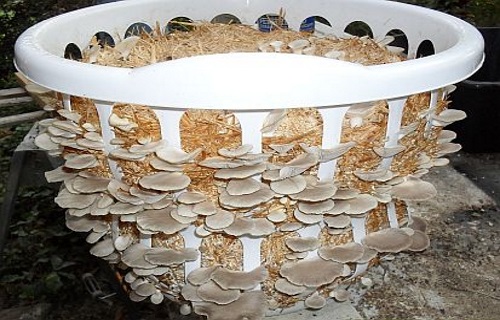
I find myself engaging in conversation in various social circles, I often bring up the topic of foraging and eating wild plants and how this survival skill is being forgotten. Oftentimes, the topic of harvesting and eating wild mushrooms is the one that captures the attention of the room.
Those that never experienced more than the store-bought mushrooms show signs of skepticism, and their attitude toward foraging suddenly changes. I often wondered why this general fear of wild mushrooms, and after doing a little bit of research, I found out why.
It turns out that in the United States, there are more than 7.000 annual cases recorded of exposure to toxic mushrooms. This means that people get in contact with various types of mushrooms, intentionally or unintentionally, and due to the toxic nature of these mushrooms, they make the statistics. Luckily, the number of cases that result in major harm or prove to be fatal is quite low, less than 40 people per year.
If you are the type of person willing to give mushroom foraging a try, you will be rewarded with a tasty, nutritional reward. In fact, mushrooms have much more protein than most vegetables, and they hold high levels of vitamins. Also, few people know that mushrooms are the only non-animal food with a vitamin D content.
Besides being a good food source, mushrooms may also have some medicinal properties, and their anticancer, antiallergenic, antioxidant, antiviral, and antibacterial properties are being tested by various scientific communities all over the world.
According to the International Journal of Microbiology, there are between 5,000 and 10,000 species of mushrooms in North America alone, so foraging for edible mushrooms can become quite challenging for the novice forager. To put things in perspective, you should know that of these 10,000 species native to North America, about 100 are considered edible and safe for human consumption.
I often like to joke with friends that all mushrooms are edible once, but you should never test this theory, no matter how hungry you are, if you get stranded in the wilderness. There are other less risky alternatives when it comes to wild edibles, and you shouldn’t consume mushrooms unless you are certain you’ve identified an edible variety.
If you want to become a mushroom hunter, I recommend learning just one or two edible mushroom species each year. After you can identify the two varieties beyond a shadow of a doubt, you can expand your knowledge to other fungi.
For your foraging trip, you should bring along a sharp knife, a few mesh bags to store and transport the mushrooms, a good camera, and one or two field guides. The mesh bags will allow for the mushroom spores to be dispersed as you walk, so make sure you’re using only those types of bags for carrying the harvest. Regarding the field guides, these are useful not only to help you identify the mushrooms but also associated trees.
The camera (which can be the one from your phone) will help you take pictures and post them on certain apps like iNaturalist or on social media, where multiple people and various experts can offer input on the mushrooms you’ve discovered. There are also various Facebook groups dedicated to foragers, and just posting a picture on such groups of a mushroom you’re not certain about will provide you with useful information from other, more experienced foragers.
When taking photos of the mushrooms, make sure you take pictures from above but also from the underneath part of the mushroom’s cap, as well as the stalk. Some species can be distinguished by the presence of pores, gills, or other spore structures.
Another trick you can use to identify mushrooms is to make a spore print and post it online. Take the mushroom cap and put it on a sheet of paper with the spore side down (belly), pour a few drops of water on the cap, and then cover it with a glass for a few hours. You will notice that a spore print of various colors and arrangements will appear on the paper after you remove the mushroom cap.
Another piece of advice I can give you is to join a local mushroom club since no matter how many guides you read or bring along, it fails in comparison to finding and seeing the mushroom in their natural environment along someone who knows how to hunt for mushrooms.
These clubs will often organize and conduct forays where people will learn how to find and identify various types of mushrooms in person. Chances are you will be standing shoulder-to-shoulder with an expert, so make sure you ask questions and bring him/her the mushrooms you find to learn more about them.
Mushrooms are a type of fungus, and unlike most garden vegetables, they grow in composted substrate rather than soil. Straw and hay bales are commonly used as the bulk ingredients in mushroom substrate because they are inexpensive and easy to use. With the right preparation, the average gardener can grow his own mushrooms at home using sterilized hay bales.
Shiitake and oyster mushrooms are the most common mushrooms grown at home, though there are many edible and medicinal species that can be cultivated. Plug, sawdust, or grain spawns cultured with a specific mushroom mycelium are available from mushroom suppliers throughout the country. Once the freshly-cut log is inoculated with the mushroom spawn, patience is the next step. Shiitake takes about a year to begin fruiting; the aggressive oyster mushroom can produce in as little as 3-4 months. Oak logs can produce shiitake for 3 or 4 years, with rest periods in between flushes.
Poplar is commonly used for oyster mushroom production, and being a softer wood, is consumed more quickly by the mushroom, but may still last 2 or 3 years. Logs need watering or soaking in the hot summer months, but can produce mushrooms until the wood disintegrates. Log-grown mushrooms can get very large compared to their commercially produced, store-bought cousins. What reward it is to step outside and pick a 6-inch shiitake for dinner!
Mushrooms can grow in a few different substrates from logs and mulch to straw. In this episode of From the Ground Up we discuss starting mushrooms in straw. The benefit of straw (or mulch) is that you get mushrooms in the same season you plant, with logs you have to wait a year.
Mushroom Club members have also been introduced to alternative methods of mushroom production. Species can be grown on hay bales, straw, sterilized grain, shredded paper, egg cartons, phone books, fabric or many other media inoculated with spawn. These methods generally begin production more quickly but don’t last nearly as long as mushrooms grown on logs.
(5064) Straw Bale Garden - Mushrooms in the Bale | Joel Karsten - YouTube
1 Sterilize the hay bales by placing them in a roasting pan or large stock pot full of boiling water until they are fully saturated. To make this process easier, it is best to use mini hay bales measuring no more than 12 inches in length.
2 Remove the bales from the water using a large pair of tongs and place them on a cooling rack set above a metal sheet pan to drain. You may need to empty the sheet pan several times so it does not overflow. Wait for the hay bales to cool to room temperature before removing them from the cooling rack.
3 Set the mini hay bales in the desired location for growing your mushrooms. Select a location that is out of direct sunlight and, if possible, will retain a stable temperature between 55 and 65 degrees Fahrenheit. You can place your bales directly on the ground or on top of a bench or table for greater comfort in caring for your mushrooms.
4 Create openings in the tops of the mini hay bales with your fingers.
5 Insert the oyster mushroom spawn into the openings you just created in the hay bales. Follow the instructions included with the mushroom spawn to determine the proper application rate.
6 Water the hay bales liberally with de-chlorinated water to keep the bales moist as the mushrooms develop. You can either purchase distilled or filtered water for your mushrooms or treat regular tap water with a de-chlorinating solution.
7 Check your hay bales several times a week and water them as necessary to keep the hay damp but not wet. After six to eight weeks, you should begin to see small mushrooms forming on the bales.
Now comes the fun part. The mushrooms essentially double in size every day, so within a week or so you should have good-sized oyster mushrooms. Mist them with water two or three times a day over this period – again, not so they are dripping, just so they are moist. The mushrooms should be harvested while their rims are still curled over a little and pointing downwards. If their rims seem to be turning upward, it’s probably time to harvest.
8 Harvest your mushrooms in the small “button” stage or let them mature for a while before picking them. Separate the mushrooms from the hay bale by gently twisting rather than pulling on them to avoid breaking the stems.
To harvest the mushrooms give them a twist at the base. This ensures that you leave the very bottom of the mushroom still in the bag. You want to leave that part behind as it is needed for the subsequent flushes of mushrooms. If you keep the mushrooms moist and in suitable conditions, you should get three or four flushes of mushrooms, although I’m told the first and second flushes are the most productive. I’m currently harvesting my second flush. When your bags stop producing, the straw can be used as mulch for the garden.
Preserving mushrooms
Mushrooms are a very valuable food in every kitchen, as they offer endless possibilities when it comes to using them. However, mushrooms are quite delicate and they require special care to preserve them from spoiling. Therefore, if you want to keep mushrooms in top condition for long periods of time, you’ll need to use a food preservation technique like dehydration, freezing, fermenting or vacuum packaging.
There are various different methods for preserving mushrooms. Mushrooms are being preserved in order to extend their shelf life. Fresh mushrooms only keep for about five days after picking. Preserved mushrooms can be kept for a longer period of time (even up to five years!)
Preserving mushrooms – freezing. Both wild and commercial mushrooms can be safely frozen, as long as they are edible. Choose mushrooms free from spots and decay. Sort according to size. Wash thoroughly in cold water. Trim off ends of stems. If mushrooms are larger than 1 inch across, slice them or cut them into quarters. Heating is required to preserve mushrooms ‘at their best.’ Either steam or saute mushrooms prior to freezing. Delicate mushrooms such as morels will benefit from a light saute prior to freezing.

Preserving mushrooms – drying.
For supreme flavor, try drying mushrooms. Not only is this the easiest way to preserve mushrooms, it also provides you with a real flavor treat. Mushrooms should be dried on a dehydrator, not out-of-doors. Either commercial or edible wild mushrooms can be safely dried. Choose mushrooms free of dirt and decay. Rinse gently and dry. Slice into sections for even drying. Place on a dehydrator tray or rack and dry until brittle or crisp. Mushroom ‘chips’ are a real taste treat. For a flavor boost, dry mushrooms and grind to a fine powder. Spoon the powder into soups and stews, or add to dough when making fresh pasta.
Dehydrating mushrooms in the air: either on a rack or by hanging them on a line, as if you were hanging clothes. You should place them in a place that’s hot or has good air flow but without much humidity.
Drying mushrooms in direct sunlight: the problem with this option are insects, bad weather, etc. Also, if you live in a humid place, it is recommended that you do not leave them outside overnight.
Using an oven to dry mushrooms: at a low temperature and with a lot of patience, as this process requires hours. Electric ovens are preferred and use a fan if you have one.

Preserving mushrooms: in their juice
This technique involves preserving mushrooms naturally in their own juice, packaged in vacuum jars. First of all, you should sterilize the jars or bottles that you will to keep the mushrooms in good condition.
Then, wash the mushrooms, chop them, blanch them and do not throw away the resulting water. Put the mushrooms in the jar with their cooking juices, filling it up to the maximum, and put the lid on firmly.
To seal the glass jars, you should boil them in a pot that is large enough so the water covers all the containers. Here you can learn more about how to seal glass jars to preserve food.

Preserving mushrooms in vinegar, oil or salt
Mushrooms can also be preserved in vinegar or oil. In Eastern Europe they mostly use vinegar, while preserving in oil is common in the Mediterranean. A well-known example are mushrooms eaten as an Italian antipasto or starter. In China, mushrooms are often preserved in salt. The distances to preserving factories in China are too large, which makes it impossible to process fresh mushrooms. A disadvantage of preserving in salt is that the mushrooms have to be rinsed in a large amount of water to prevent them from tasting too salty. This does not have a favourable effect on the flavour. That is one of the reasons why consumers around the world choose Dutch preserved mushrooms. Because the processing industry and the growers are located so close to another, mushrooms can be processed immediately after harvest. Therefore Dutch mushrooms retain their strong fresh mushroom flavour, whether packed in a can, jar, bag or bucket.
A grand encyclopedia of country Self Sufficient Backyard , weather wisdom, country remedies and herbal cures, cleaning solutions, pest purges, firewood essentials, adobe making and bricklaying, leather working, plant dyes, farm foods, natural teas and tonics, granola, bread making, beer brewing and winemaking, jams and jellies, canning and preserving, sausage making and meat smoking, drying foods, down-home toys, papermaking, candle crafting, homemade soaps and shampoos, butter and cheese making, fishing and hunting secrets, and much more. Self Sufficient Backyard: Traditional Skills for Simple Living
(5063) Canning Mushrooms - Start To Finish - YouTube
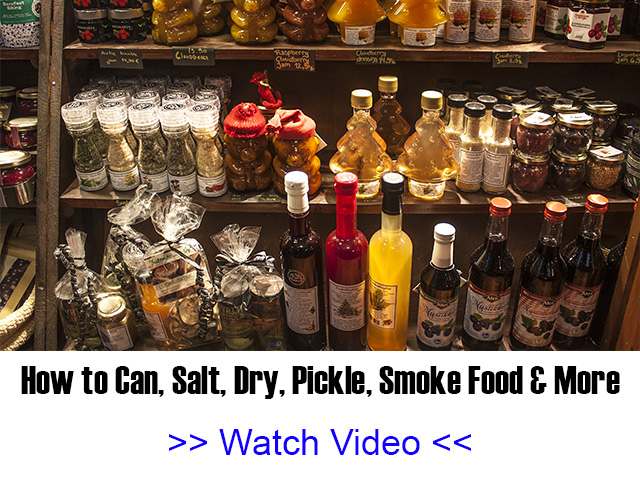
Books can be your best pre-collapse investment.
Carnivore’s Bible (is a wellknown meat processor providing custom meat processing services locally andacross the state of Montana and more. Whether your needs are for domestic meator wild game meat processing)
The Lost Book of Remedies PDF ( contains a series of medicinal andherbal recipes to make home made remedies from medicinal plants and herbs.Chromic diseases and maladies can be overcome by taking the remediesoutlined in this book. The writer claims that his grandfather was taughtherbalism and healing whilst in active service during world war twoand that he has treated many soldiers with his home made cures. )
Easy Cellar(Info about building and managing your root cellar, plus printable plans. The book on building and using root cellars – The Complete Root Cellar Book.)
The Lost Ways (Learn the long forgotten secrets that helped our forefathers survive famines,wars,economic crisis and anything else life threw at them)
LOST WAYS 2 ( Wordof the day: Prepare! And do it the old fashion way, like our fore-fathers did it and succeed longbefore us,because what lies ahead of us will require all the help we can get. Watch this video and learn the 3 skills that ensured our ancestors survival in hard times offamine and war.)
Growing Mushrooms in Straw Bales & How to Preserve Mushrooms - PrepperFortress
If you're gonna fight, fight like you're the third monkey on the ramp to Noah's Ark... and brother its starting to rain. Join our efforts to Secure America's Borders and End Illegal Immigration by Joining ALIPAC's E-Mail Alerts network (CLICK HERE)
-
07-10-2023, 02:21 PM #7808
50 Toxic Plants: The Silent Slayers at Your Farm
CARMELA TYRELL May 28, 2023 No Commentson 50 Toxic Plants: The Silent Slayers at Your Farm
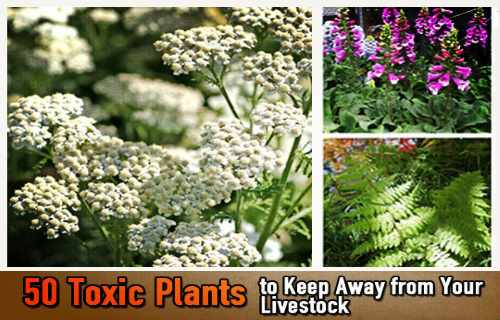
Once you buy enough land to support a survival farm and choose the kinds of animals that will live on it, you will still have a long way to go before creating a viable and sustainable farm. Unfortunately, many people that create survival farms fail to realize that toxic plants can easily wipe out all animals on the farm, or make milk and other products inedible.
In order to prevent this from happening, you should be aware of plants that are poisonous or harmful to animals you plan on keeping as well as make sure you understand how they get introduced into your grazing areas.
Common Ways Toxic Plants Get Introduced to Grazing Areas
Surprisingly enough, some of the most toxic plants to livestock come straight from the nursery. This includes herbs, flowers, fruits, and even vegetables that you may decide to grow for food, medicine, or landscaping purposes.
If you visit the local plant nursery, you are sure to be surprised to find many plants and seeds are available for vegetation that does not naturally grow in your area. Some natural perennials may grow as annuals or biennials in your area.
In other situations, the plants you buy may actually turn into an invasive species.
No matter how long these plants grow in your area, they will still be poisonous to livestock. See below the list of the most common 50 plants to avoid when feeding your farm animals, in order to keep them healthy and safe.

Securing Grazing Land from Toxic Plants
If you are determined to grow these plants, then be sure they will be located in an area where livestock cannot get to them.
In addition, some plants have pollen that can contaminate water and other resources. This exposure can be fatal to sensitive animals without you even realizing where the problem came from.
Therefore, you may want to isolate these plants in a greenhouse or take other measures to prevent these plants from coming into contact with livestock.
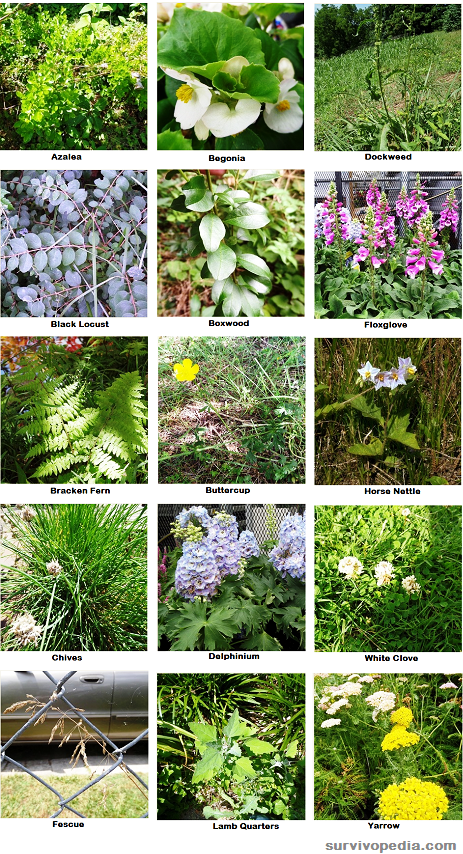

Keeping Grazing Areas Free of Toxic Plants
Aside from avoiding plants that may harm livestock, there are many native plants or weeds that will need to be removed from grazing areas. You can use a combination of four methods to eliminate toxic plants from pastures:
- Use herbicides that will not harm livestock. Most commercial herbicides will only get rid of specific species of plants. You can just as easily use a mixture of vinegar and dish detergent on a hot sunny day and spray it just on plants to be eliminated.
- Manually uproot plants and burn them in an area where smoke filled with plant oils will not get near livestock or human living areas.
- Look for plant species that will crowd out poisonous plants or prevent them from thriving. Essentially this is the opposite of companion planting for your garden.
- Make the soil as inhospitable as possible to poison plants by altering the pH or other methods. Just be sure that grass or other intended pasture plants can grow in the area and provide proper nutrition for livestock.
- With your seeds kit, you’ll also receive a FREE Medicinal Guide that shows you how to turn these 10 plants into tinctures, ointments, salves, poultices, decoctions, infusions, essential oils —all in minute detail so you can follow our guide even if you’ve never made an herbal medicine in your life.
Symptoms of Poisoning in Livestock by Most Common Toxin Types and Treatment
No matter how hard you try, there are going to be a few poisonous plants that slip into pasture lands. In most cases, the animal may be sick for several days before making a full recovery.
Unfortunately, there are also some plants that are so toxic just a few berries or leaves will kill an animal within hours.
It is very important to realize that the following emergency treatment methods may still fail even if the animal does not look very sick. The amount of toxin consumed, emptiness or fullness of stomach at time of ingestion, and many other factors will contribute to success or failure of treatment.
The emergency treatments in the following chart is based on the general class of poison. Many plants have specific toxins within each category that may require additional or specialized treatment. But there are hundreds of poisonous plants and also hundreds of chemicals that are well beyond discussion here. You can contact poison control centers and find out more about specific treatments if you so choose.
That being said, in a crisis situation these resources may not be available. In that case, perhaps it can be said that trying these generalized remedies is better than not trying anything at all.
In order to determine which plant poisoned livestock, you can look at material vomited for bits of plant material, take note of breath odor, and also look in the area for plants with signs of chewing on them.

Toxins, Symptoms and Basic Treatments
Alkaloid
- Symptoms of poisoning: Diarrhea, vomit, weakness, collapse, fever, confusion, muscle twitching, apparent blindness, nervous walking, drooling.
- Basic treatment: Alkaloid poisoning can occur over a period of days or more quickly depending on amount consumed. It is best to isolate the animal and see if it recovers; however it will usually be more prone to disease and stunted growth. For scopolamine and atropine poisoning, try giving vinegar orally since it is an acid that can help lower pH.
Glycoalkoid
- Symptoms of poisoning: Vomit, diarrhea, dizziness, dilated pupils, paralysis, fever, hypothermia.
- Basic treatment: If animal has diarrhea, allow to continue until toxin is flushed out. Watch for dehydration and try to prevent. If no diarrhea, try to induce vomiting as a last resort.
Glycoside
- Symptoms of poisoning: Muscle tremors, seizures, rapid breathing, vomiting, diarrhea, colic.
- Basic treatment: Some poisons in this class can kill in minutes and with very little exposure. For cattle and horses, feed activated charcoal at 2 grams per 2 -3 kg of body weight (or some say 1 – 3 grams per kg). The charcoal will absorb any poison that has not yet gotten into the bloodstream. Induce vomiting in species where vomiting is possible.
Lecitin
- Symptoms of poisoning: Panting, rapid heartbeat, bright red mucus membranes. In later stages, mucus membranes and skin will turn pale and temperature decreases
- Basic treatment: Epinephrine injection if available – you will need to find out how much to use based on animal’s weight. Administer IV fluids to keep blood pressure up
Mycotoxin
- Symptoms of poisoning: Lack of appetite, dark stool, low milk production, increased risk of infections. Short term symptoms include vomit, tremors, weakness, fever, increased heart rate, dehydration, seizure.
- Basic treatment: Eliminate moldy foods from feeding areas, prevent grazing in pastures where mold or fungi are present. Induce vomiting if appropriate for species, then administer activated charcoal. Use anti-seizure medication if available based on animal weight. IV fluids may also help if animal is in shock.
Nitrates
- Symptoms of poisoning: Trembling, rapid breathing, difficulty walking or moving. If the poisoning is over long periods of time, cattle may abort, also poor growth and low milk production. To avoid nitrate poisoning in usually safe plants, do not use ammonium sulfate or urea (usually derived from urine) as a fertilizer source.
- Basic treatment: Isolate animal from foods that may contain nitrates. Administer Methylene Blue (usually available in tropical fish supply stores) via IV. It may require several doses. Methylene Blue is very irritating to skin; so cannot be administered orally. Note – these animals may no longer be fit for human consumption.
Oxalates
- Symptoms of poisoning: Mouth pain, swollen tongue or lips, increased salivation, throat swelling, drooling.
- Basic treatment: Keep airway open, use antihistamines if available and safe for species being treated.
Phenols
- Symptoms of poisoning: Burns around or in mouth, vomit, diarrhea, seizures, and sweating, rapid heartbeat.
- Basic treatment: Make sure you are wearing garments and gloves that reduce risk of exposure to phenols since they are easily absorbed through skin and via air. Try to induce vomit and then administer activated charcoal to absorb any poison remaining. If possible, intubate the animal and use CPR for animals. Usually there is no cure for phenol poisoning.
When it comes to raising animals on a farm, many people do not realize how many toxic plants exist in nature, let alone ones that can be introduced to satisfy other interests. In addition, the types of poisons and their treatment can be very complicated.
That said, if you notice an animal with symptoms of poisoning, you can try a few things to keep the animal alive and help it to recover.

Books can be your best pre-collapse investment.
Easy Cellar(Info about building and managing your root cellar, plus printable plans. The book on building and using root cellars – The Complete Root Cellar Book.)
The Lost Ways (Learn the long forgotten secrets that helped our forefathers survive famines,wars,economic crisis and anything else life threw at them)
LOST WAYS 2 ( Word of the day: Prepare! And do it the old fashion way, like our fore-fathers did it and succeed long before us, because what lies ahead of us will require all the help we can get. Watch this video and learn the 3 skills that ensured our ancestors survival in hard times of famine and war.)
This article has been written by Carmella Tyrell for Survivopedia.com.
50 Toxic Plants: The Silent Slayers at Your Farm - PrepperFortress
If you're gonna fight, fight like you're the third monkey on the ramp to Noah's Ark... and brother its starting to rain. Join our efforts to Secure America's Borders and End Illegal Immigration by Joining ALIPAC's E-Mail Alerts network (CLICK HERE)
-
07-10-2023, 02:23 PM #7809
Native Americans Plants Use To Cure Everything – Miracle Plant That Cures Cancer, Hepatitis, Liver, Kidneys
Amy S. May 28, 2023 4 Commentson Native Americans Plants Use To Cure Everything – Miracle Plant That Cures Cancer, Hepatitis, Liver, Kidneys

The Cherokee is a Native American tribe that is indigenous to the Southeastern United States. They believe that the Creator has given them a gift of understanding and preserving medicinal herbs. The Cherokee trust the healing and preventative properties of nature’s pharmacy. Because many plants become scarce throughout history, the Cherokee promote proper gathering techniques. The old ones have taught them that if you are gathering, you should only pick every third plant you find. This ensures that enough specimens still remain and will continue to propagate. Here are some of the medicinal plants that were commonly used and foraged for by the Cherokee tribe.
However, the following plants were used by this tribe in the treatment of almost every single illness and health condition. However, before we explain their properties, we must warn you that they can be quite strong and dangerous if not used properly.
Keep in mind that the Cherokee healers were experienced as they had centuries of practice. Furthermore, it is of high importance to understand their value as powerful natural medications, so you should be gentle when scavenging them.
These are the natural plants that provide amazing health benefits:

Blackberry.
Cherokee used blackberry for treating almost everything, including an upset stomach, strengthening the immune system, cancer prevention, improving digestion, and better heart functioning. By making a tea of its root, this tribe healed swelling of joints and tissues. And if you make a decoction from its roots, thus sweetened with maple syrup or honey, you will get great syrup for treating cough. Chewing the blackberry leaves can soothe bleeding gums.
Blackberries an amazingly nutritious because they are rich in vitamins A, C, B6, E, K, riboflavin, thiamine, folate, and minerals such as iron, calcium, magnesium, potassium, zinc, and phosphorous.
To the Cherokee, the blackberry is the longest known remedy to an upset stomach, however this herb can be used for just about anything. Using a strong tea from the root of blackberry helps to reduce swelling of tissue and joints. A decoction from the roots, sweetened with honey or maple syrup, makes a great cough syrup. Even chewing on the leaves of blackberry can sooth bleeding gums.

Some other health benefits of blackberry fruit include
•better digestion
•strengthened immune system
•healthy functioning of the heart
•prevention of cancer
•relief from endothelial dysfunction
Herbs and other naturalremediescan be as effective as traditional treatments, often without the same negative side effects,” says Roberta Lee, MD, medical director of the Continuum Center for Health and Healing at Beth Israel Medical Center in New York City.Here are 10 super healersyou’ll want to add to the all-natural section of your medicine cabinet—and even to your favorite recipes. Folding one or two of them into your cooking every day can yield big benefits.
These tasty berries are also incredibly nutritious. Vitamins provided by blackberries include vitamin A, vitamin B6, vitamin C, vitamin E, vitamin K, thiamine, riboflavin, niacin, and folate. Blackberries also have an incredible mineral wealth of calcium, iron, magnesium, phosphorous, potassium, and zinc. They are also a good source of dietary fiber and essential amino acids.

Hummingbird Blossom (Buck Brush)
Cherokee used this plant for the healing of fibroid tumors, cysts, mouth/throat problems, and inflammation. In addition, they mainly used hummingbird blossom in order to stimulate kidney function, but it was also used in the treatment of enlarged lymph nodes, hemorrhoids, inflamed tonsils, enlarged spleens, and menstrual bleeding. In order to get all healing benefits of this plant, they put the flowers and the leaves in boiling water for 5 minutes, and then drink the tea while it’s still hot.
Hummingbird blossom has been used by the Cherokee for treatment of cysts, fibroid tumors, inflammation, and mouth/throat problems. Present day research has concluded that this herb is also great for treating high blood pressure and lymphatic blockages.
The Cherokee mainly use hummingbird blossom as a diuretic to stimulate kidney function, h
•inflamed tonsils
•enlarged lymph nodes
•enlarged spleens
•hemorrhoids
•menstrual bleeding.
To get all of the benefits from hummingbird blossom, the Cherokee would steep the leave and flowers in a boiling water for about five minutes then drink the tea while it is still warm.

Qua lo ga (Sumac)
Every single part of this herb can be used for medicinal purposes! Sumac bark can be made into a mild decoction that can be taken to soothe diarrhea. The decoction from the bark can also be gargled to help with a sore throat. Ripe berries can make a pleasant beverage that is rich in vitamin C. The tea from the leaves of sumac can reduce fevers. You can even crush the leaves into an ointment to help relieve a poison ivy rash. A study published in Iranian Journal of Pharmaceutical Research reported that sumac, if added to daily diet, can help lower cholesterol levels.
Each part of this plant might be used for medicinal purposes in the treatment of diarrhea, sore throat, and fevers (by making a decoction from the bark). In addition, if you want to get rid of poison ivy rash, you need to crush the leaves into an ointment.

RELATED : Wild lettuce is used for whooping cough, asthma, urinary tract problems, cough, trouble sleeping (insomnia), restlessness, excitability in children, painful menstrual periods, excessive sex drive in women (nymphomania), muscular or joint pains, poor circulation, swollen genitals in men (priapism), and as an opium substitute in cough preparations.

Cattail.
The Cherokee tribe considered this plant as a preventative medicine and they used it as a digestible food for recovery from each illness. Almost each part of the plant (except its seed heads) can be used for medicinal purposes. Its root can be prepared like potatoes, mashed or boiled for treating sores and burns. The seed down from its flowers is used for diaper rash in babies in the treatment of skin irritation.
Greenbriar (Pull Out a Sticker).The leaves and stems of this plant are rich in numerous minerals and vitamins while its roots are high in starch and they can be used like potatoes. Although its root has a strange and harsh taste, it’s rich in calories. Cherokee used this plant as mild diuretic and a blood purifier in the treatment of urinary infections. Its leaves might be put in a tea to heal arthritis! Its berries might be eaten as jam or raw.
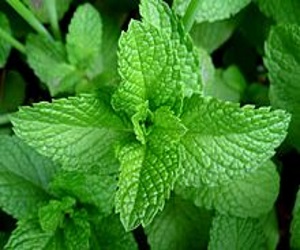
Mint.
Being a very popular herb, mint is commonly used in tea because of its numerous antioxidant properties. It possesses phosphorus, magnesium, potassium, vitamins C,A, calcium, and fiber! The Cherokee used the leaves of this plant crushed as cold compresses, or made into ointments, or even added in the bath to calm down and itchy skin. Moreover, they used a mixture of leaves and stems in order to reduce high blood pressure.
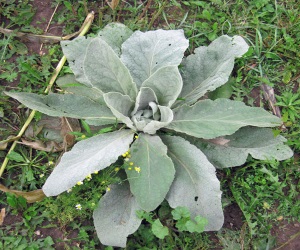
Mullein.
This herb soothes chest congestion and asthma. If you inhale the smoke from burning mullein leaves and roots, it will calm your lungs. This plant is exceptionally useful in soothing the mucous membranes. Due to its anti-inflammatory features, it calms the irritated and painful tissue and joint. Mullein flowers are used to prepare tea that contains a lot of mild sedative effects.

Big Stretch (Wild Ginger).
A tea made of the root of this plant was used by Cherokee in order to improve digestion, intestinal gas, colic, and upset stomach. A stronger tea from its root can even remove lungs secretion. You might use rootstocks from this plant instead of regular ginger and its flowers for flavoring your favorite recipe.
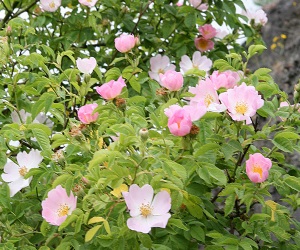
Jiddu Unigisdi (Wild Rose).
The fruit of this plant is high in vitamin C and is a great healing remedy for flu and cold. The Cherokee made a tea out of wild rose hips in order to stimulate kidney and bladder function. You can even try to make a decoction from its root to treat diarrhea.

Squirrel Tail (Yarrow).
Being known best for its blood-clotting features, the leaves of this plant (fresh or crushed) might be put to open wounds in order to prevent excess bleeding. The juice of this plant, when mixed with spring water, might stop intestinal illnesses and internal stomach bleeding. Its leaves can be used for tea in order to help in proper digestion and stimulate abdominal functions.

Kawi Iyusdi (Yellow Dock).
The Cherokee used this herb in their cuisines because it’s quite similar to spinach. But, it possesses a lot more minerals and vitamins because of its long roots gathers nutrients from deep underground.

Dandelion
Even though considered a weed, dandelion root has a long history of therapeutic use. In fact, this extremely beneficial plant has the ability to treat allergies, lower cholesterol levels, stimulate the production of bile, and detoxify the liver. It also has diuretic properties and it is especially beneficial for pregnant and menopausal women.
The best time to harvest dandelion root is in the spring, especially in the beginning of April. Make sure you pick it from places which are less polluted, such as areas away from the town and the road.
The best part about dandelion is that all parts of it have medicinal properties. For instance, the leaves are abundant in vitamins and can be used in a salad, along with potatoes and eggs. The stem relieves stomach issues, stimulates the gallbladder function, regulates the metabolism, and purifies the blood. Moreover, the stem can be used to treat diabetes while the milk from the stem can be used to remove warts.
Ultimately, people use dandelion flowers to prepare homemade dandelion syrup which purifies the blood, relieves a cough, and improves digestion.
DANDELION SYRUP RECIPE
Get 400 yellow dandelion flowers and pour 3 liters of water over them. Then, cut 4 oranges and 4 lemons into slices and add them to the mixture. Leave the mixture for 24 hours.
After 24 hours, strain the mixture and pour the liquid into a pot. Add 2 cups of sugar into the pot and cook for about half an hour.
Once the mixture boils and gets thick enough, remove from heat and transfer the syrup into sterilized jars. Use the dandelion syrup to treat cold, cough, or bronchitis.
HEALTH BENEFITS AND CANCER-FIGHTING PROPERTIES OF DANDELION ROOT
Dandelion has been long used and appreciated for its medicinal properties. Today, the modern medicine confirms its health benefits and suggests that it is even capable of curing cancer. Keep watching to learn more about preparing and storing roots for future use.
You need to peel, cut, and dry the dandelion roots on a fresh air. Let them dry for about two weeks or until they become brittle under the fingers. Once dried, put them into a jar and store in a dark and cool place.
Dandelion root has the ability to clean the kidneys, liver, lymph and gallbladder, which makes it effective at treating gallstones, constipation, hepatitis, acne, edema, and rheumatism. Moreover, it is very beneficial for women, especially for prevention and treatment of issues related to breastfeeding as well as cysts, tumors, and cancer.
HOW TO PREPARE DANDELION TEA?
Pick some leaves, dry, chop and mince them well. Store the mixture in a jar and keep for future use. To prepare the tea, you need to add half a teaspoon of the mixture into a glass of water. As simple as that!
Another option is to mix 60 grams of a fresh mixture and 30 grams of dried dandelion root. Put this mixture into a pan along with 2.5 ounces of water with a pinch of salt. Bring the boil, cover the pan, and simmer for about 20 minutes. Strain the liquid afterward and consume three cups daily.
- Medicinal Garden
- With your seeds kit, you’ll also receive a FREE Medicinal Guide that shows you how to turn these 10 plants into tinctures, ointments, salves, poultices, decoctions, infusions, essential oils —all in minute detail so you can follow our guide even if you’ve never made an herbal medicine in your life.

Books can be your best pre-collapse investment.
Carnivore’s Bible (is a wellknown meat processor providing custom meat processing services locally andacross the state of Montana and more. Whether your needs are for domestic meator wild game meat processing)
The Lost Book of Remedies PDF ( contains a series of medicinal andherbal recipes to make home made remedies from medicinal plants and herbs.Chromic diseases and maladies can be overcome by taking the remediesoutlined in this book. The writer claims that his grandfather was taughtherbalism and healing whilst in active service during world war twoand that he has treated many soldiers with his home made cures. )
Easy Cellar(Info about building and managing your root cellar, plus printable plans. The book on building and using root cellars – The Complete Root Cellar Book.)
The Lost Ways (Learn the long forgotten secrets that helped our forefathers survive famines,wars,economic crisis and anything else life threw at them)
LOST WAYS 2 ( Wordof the day: Prepare! And do it the old fashion way, like our fore-fathers did it and succeed longbefore us,because what lies ahead of us will require all the help we can get. Watch this video and learn the 3 skills that ensured our ancestors survival in hard times offamine and war.)
Native Americans Plants Use To Cure Everything - Miracle Plant That Cures Cancer, Hepatitis, Liver, Kidneys - PrepperFortress
Last edited by Airbornesapper07; 04-07-2024 at 02:08 AM.
If you're gonna fight, fight like you're the third monkey on the ramp to Noah's Ark... and brother its starting to rain. Join our efforts to Secure America's Borders and End Illegal Immigration by Joining ALIPAC's E-Mail Alerts network (CLICK HERE)
-
07-10-2023, 02:26 PM #7810
Growing Vegetables in Straw Bales (Straw is Like a Sponge and Holds an Amazing Quantity of Water)
Amy S. May 26, 2023 1 Commenton Growing Vegetables in Straw Bales (Straw is Like a Sponge and Holds an Amazing Quantity of Water)
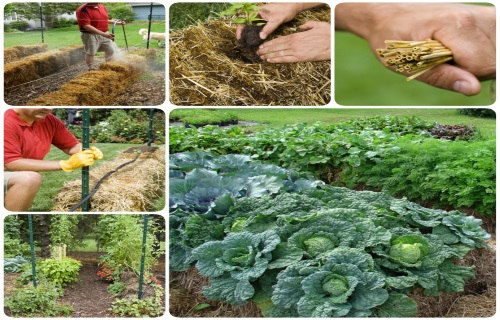
Worries about the down economy and food safety are fueling a boom in home gardens. However, many people don’t want to toil in the garden, or they don’t have enough yard space.We have the answer: straw bales.
Straw bale gardening: is it any good?
Easy, economical and efficient, the humble straw bale is raising the stakes for veg production.
Straw bale gardening is not something I’ve tried before, but it is on the cards for this year. The technique has been around since the Sixties, if not earlier. An American horticulturalist, Joel Karsten, has been honing his cultivation techniques using this system for 22 years and now grows almost all his vegetables and herbs this way, using 25 bales to supply his family’s needs.
He is evangelical about the technique. In many ways it is like growing in raised beds without having to make the raised beds. BBC Radio 4’s Gardeners’ Question Time has had numerous queries from schools and clubs hoping to grow crops on hard surfaces or flat roofs, and this is possibly the least expensive and most effective system without having to lift the concrete or tarmac.
Karsten reckons that veg and fruit plants are about 25 per cent more productive in bales than they are in the ground. This can be attributed to more oxygen to the roots (we are increasingly realising the importance of this), together with unlimited water (straw is like a sponge and holds an amazing quantity of water) and nutrients. Added to this, heat from decomposition of the straw means that crops are produced earlier, the cropping period is extended later in the year, too, and the produce is generally larger. Karsten calculates that 75 per cent less labour is involved – bales never need weeding.
The most labour-intensive part is the initial “conditioning” – adding water and fertiliser so the bales start to decompose inside, which takes about 10-14 days. On the first day you spread 4oz of a nitrogen-rich lawn fertiliser evenly over the top before gently washing it in with 1-2 gallons of water (this takes a minute or so). The fertiliser does not need totally washing in. When water is coming out of the bottom, stop. For the next nine days or so you carry on, some days adding fertiliser, some days not. If you are organic, you can add organic fertiliser instead but increase the quantity six fold (and source organic straw). After the fifth day use water from a butt or water that has been left in a bucket overnight so it is not as cold as from the tap. Finally, immediately before planting, add a seep hose along the top (if you don’t want to hand water) and on the 11th day plant or sow.
Sowing involves spreading a 1-2in layer of multi-purpose compost along the entire top of the bale, before sowing the seeds. As for planting, you just stab the immediate area with a trowel to make a hole wide enough to receive the plug/pot and push the plant in. Remove a small bit of straw if necessary. I plan to plant three tomato plants per bale and will probably add some marigolds to help deter whitefly, and might well plant parsley up the sides, too.

Karsten even grows potatoes this way (three plants per bale) – they are clean on harvesting, extremely easy and highly productive, so I am tempted. My thin, limey soil means potatoes are prone to scab, but the bales’ moisture-rich environment will help prevent this. Sweetcorn, however, is not ideal – this is a huge plant and can only be grown two per bale, so it is hardly worth it. Perennial vegetables are out of the question, too, as the bales will last for a maximum of two years. After this they become mushy but are great for compost or adding to borders. Otherwise, parsnips, turnips, lettuce – indeed, just about everything – will grow. As to watering interval, a grower in North Carolina applied only a gallon a week per bale during drought periods and nothing suffered. Soluble fertiliser is added every few weeks.
What to grow
You can grow crops from seed or plant seedlings — just as you would in a raised bed or in the ground. For seedlings, consider tomatoes, eggplants, peppers and spring greens. If you’re planting from seed, start with beans, cucumbers and squash. Carrots, beets, sweet potatoes and potatoes can be grown well but are a bit trickier.
How to prepare the bales
Before you can plant in the bales, they need some special preparation, so buy the bales at least two weeks before you want to plant. Place the bales where you want to grow; once they are prepared, they will be too heavy to move.
Nitrogen sources:
Conventional lawn fertilizer (29-0-4 NPK). Make sure it doesn’t include pre-emergent weed-killer. Use 1/2 cup per bale, per application
Blood meal. Use 3 cups per bale, per application.
The first week
- Water the bale thoroughly, until water runs out the bottom of the bale. Sprinkle the surface with a nitrogen source (see box), applying at the recommended rate.
- Every other day, add more of the nitrogen source; water thoroughly. Do it a total of three times during the first week.
- On the days you don’t apply nitrogen, just water the bales thoroughly.
The second week
- For the next three days, apply the nitrogen source daily at half the original rate. Follow up with thorough watering.
- After three days of adding nitrogen, water daily.
- At the end of the week, sprinkle each bale with 2 cups of balanced fertilizer, such as organic 5-5-5. Water thoroughly.
Why so much nitrogen? It jump-starts the composting process and creates an ideal environment for plant roots. Over the course of the two weeks, the bales heat up considerably and can reach temperatures of 125 degrees F or more.
After the two weeks of treatment, the bales are ready for planting. The internal temperature should be about 75 to 80 degrees F, which you can verify with a compost thermometer. Probe from side of the bale, about halfway down. Low-tech option: Use your finger. The interior should feel warm, but not hot. If the bale still feels too hot, wait another couple days and check again.
To take back your health by growing your own groceries, and making your own food out of basic ingredients, such as cheese, bread and even chocolate to name a few…
Then you could stockpile the excess produce for dark days… (The shelf life of ingredients is longer than that of the resulting foods, anyway…) So while other preppers pay thousands for overpriced, highly-processed “emergency food”, you’ll build your survival stockpile for free…
It’ll be like having your own personal supermarket just a few feet away from you… Though not the kind that sells processed meat full of hormones and steroids, veggies full of pesticides that have absolutely no taste at all, not to mention and all the other junk full of preservatives…
How to plant
To plant seedlings — tomato, pepper, eggplant and greens — make a gap or divot in the top of the bale and set the roots in place. Fill in around the roots with a good-quality, peat-based potting soil, ensuring that the seedlings are well-seated and level with the surface of the bale. Water gently and, if needed, add more soil to fill gaps and stabilize the seedling.
Just planted: red Russian kale and collard seedlings.
Plant no more than two tomato, pepper or eggplant seedlings per bale. I’ve found that all tomato varieties — indeterminate, determinate and dwarf — work well in bales. Success depends upon the ability to adequately support them. If you can’t provide a tall stake or fencing behind the bale, choose determinate or dwarf varieties. For other crops, use the spacing that’s recommended for the variety you choose.
To plant crops from seed, spread a 2-inch layer of moistened, peat-based potting soil on the top of the bale. Avoid bagged “topsoil,” which is too coarse for good germination and can become waterlogged. Tamp it down, make it smooth and water lightly. Plant seed at the recommended depth and spacing. Be sure to water regularly during germination.
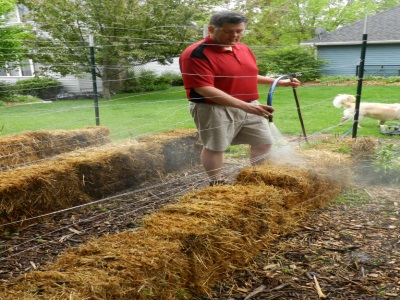 Two prepared bales, top-coated with potting mix. Squash seeds will be planted here when warm weather arrives.
Two prepared bales, top-coated with potting mix. Squash seeds will be planted here when warm weather arrives.

Stakes and supports
A good way to support tall plants, such as tomatoes, is with sturdy stakes hammered through the bale and into the ground underneath. Wire tomato cages work for medium-sized plants, such as peppers, eggplants and compact tomatoes, but taller plants can end up a bit unstable as they become laden with the harvest and the bales soften.
When growing in straw bales, it’s worth considering compact varieties, which can be surprisingly productive.
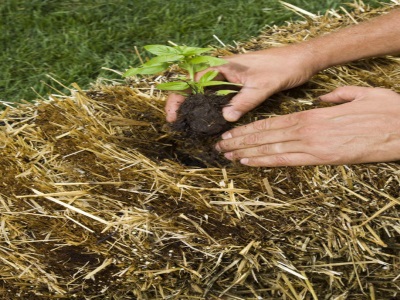 To support tall plants growing in bales that are placed on a hard surface, anchor sturdy stakes to the back of the bale.SHOP FOR VEGETABLE SUPPORTS
To support tall plants growing in bales that are placed on a hard surface, anchor sturdy stakes to the back of the bale.SHOP FOR VEGETABLE SUPPORTS
Care and troubleshooting
Bales can dry out quickly because they are above ground and permeable. Be sure to water regularly.Drip irrigation or a soaker hose, draped across the top, work well.
 Squash seedlings with mushrooms, which are common early in the season. The harmless mushrooms can be left in place. They will disappear quickly.
Squash seedlings with mushrooms, which are common early in the season. The harmless mushrooms can be left in place. They will disappear quickly.
Similarly, regular feeding is important, because frequent watering will lead to nutrient loss more quickly. Feed your crops once a week with a balanced, water-soluble plant food.
Because the bales are elevated, it helps deter certain critters, such as rabbits. I’ve found slugs to be a bit of a bother to bush beans. A sprinkling of diatomaceous earth helps with this issue.
By the end of the season, the bales will break down, the extent depends on the crops grown in them and the weather. Some hold up well enough to plant garlic in the fall. Others collapse into a rich mound of compost, perfect for adding to containers, amending garden beds or tossing in the compost pile.
Best Plants to Grow in Straw Bales
The great thing about straw bale gardening is that you can grow just about anything in a bale that you can in the ground; however, some plants grow better in bales than others. In this chapter, you’ll learn which vegetables and fruiting plants thrive best in straw bale “soil” and how many of each you can grow per bale.
Plants that don’t do well in straw
The list of straw-wary plants is pretty slim, so let’s start with the few that should be avoided.
Top-heavy plants like standard corn are too tall and heavy—a straw bale may break apart under their weight, or it may topple over. If you do want to grow corn, choose a dwarf variety instead. As the bales naturally raise the plants off the ground by a foot or two, top-heavy plants are at risk of being blown over by the wind (although good supports should help to avoid this).
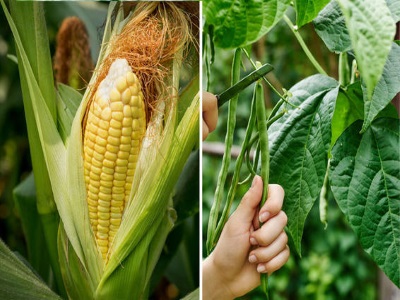 Running plants, or plants that spread by growing “offshoots” with their own roots, can be hard to manage in a straw bale your first time around. Save these for your second season.
Running plants, or plants that spread by growing “offshoots” with their own roots, can be hard to manage in a straw bale your first time around. Save these for your second season.
How to grow tomatoes in straw bales
As a relatively costly fruit to buy, warmth-loving tomatoes are a popular choice with home gardeners everywhere. Tomatoes are a member of the nightshade family and are easy to grow in straw bales. Growing them in straw is relatively similar to growing them in earth.
 Tomatoes are fantastic straw bale candidates and come in nearly endless varieties. Photo by knitsteel
Tomatoes are fantastic straw bale candidates and come in nearly endless varieties. Photo by knitsteel
Tomatoes need full sun and will need support unless you are growing a bushy or tumbling variety with small fruits.
Planting them directly into the bales
Providing it’s warm enough, you should have no problem getting your tomatoseeds to germinate and grow if you prefer to plant them directly into the bales. Plant the seeds at the depth specified on the pack, or around a quarter of an inch. However, tomato seeds do need a temperature range of 70° to 80°F (21° to 27°C) to germinate so you may prefer to start them off in pots in the house.
Planting from pots
If you are planting young plants from pots, ensure you make a hole deep enough to get all of the roots and an inch or two of the stem into the bale. This is because tomatoes have tiny hairs on their stems, called adventitious roots, which can develop into roots if they come into contact with a growing medium. The result for you is tomato plants with a stronger root system, which can only be good.
Best tomato varieties for straw bale gardening
Start small with the cherry tomato varieties (they weigh less) and, if all goes well, install stronger supports for some beefsteak or brandywine tomatoes for your second season.
Some straw-friendly varieties include:
- Sungolds (they’re easy to grow and taste extra-sweet, too!)
- Black cherries (for real tomato flavor in a small package)
- Carmellos and stupices: they’re great mid-sized varieties that won’t overwhelm your bales.
Root vegetables and tubers
Root vegetables and tubers are two great, low-maintenance options for straw bale gardening. They strive in straw bales because their roots can spread more easily than in dirt and their stems have a much easier time making it to the surface to grow into a plant. Root vegetables of all kinds grow best in loose or tilled soil that retains moisture but drains easily—that’s the very definition of straw.
Reinforce your root veggie bales
Make sure you use reinforcements around the bales (like containers or fencing) as the root vegetables’ growth may weaken the bales over time. Wire fencing, wooden frames, and large containers work perfectly.
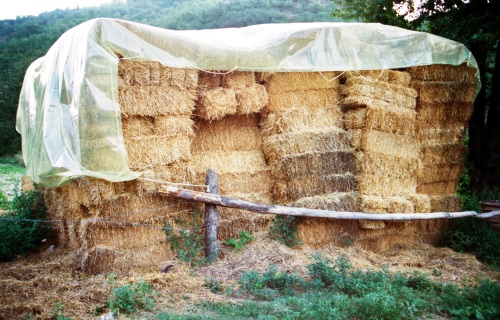 How to grow potatoes in straw bales
How to grow potatoes in straw bales
Potatoes, the world’s most well-known tubers, are perfectly suited to straw bale gardening. The huge advantage of growing potatoes in a straw bale has to do with depth. Because the baby potatoesform on the stem, you would normally need to build soil up around them in order to keep them underground. If you plant the potatoes too deep in soil to begin with, the stem may struggle to reach the surface and grow into a plant.
 Keep them covered
Keep them covered
With straw bale gardening, you can avoid this problem because the stems can grow more easily up through the straw. Plant your seed potatoes 4-6 inches deep and make sure they are well covered with straw to avoid any light reaching the tubers, as this can turn them green. Keep covering the stems as they emerge, ensuring that only 1 inch is showing at any time.
If that sounds too much like hard work, you can also plant the potatoes at a depth of 16-18 inches and leave them to it.
Early-maturing varieties such as Yukon Gold or Red Pontiac grow well in straw. Your crop will need a lot less cleaning than potatoes grown in soil – just wipe off the damp straw and you are ready.
Carrots
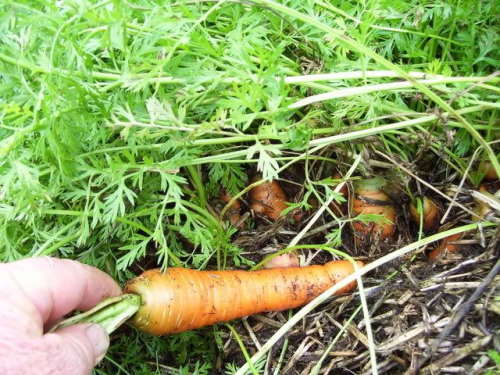 Carrots, like potatoes, are easy to grow in straw. They come in many colorful varieties, from classic orange to white, yellow, and purple. Plant them mid-spring and give them 2-3 months of growing time before harvesting. Because carrots are easily bruised, it’s better to pick them with your hands and skip any metal tools. To make this easier, wet the bale shortly before harvest and the carrots will slip free much quicker.
Carrots, like potatoes, are easy to grow in straw. They come in many colorful varieties, from classic orange to white, yellow, and purple. Plant them mid-spring and give them 2-3 months of growing time before harvesting. Because carrots are easily bruised, it’s better to pick them with your hands and skip any metal tools. To make this easier, wet the bale shortly before harvest and the carrots will slip free much quicker.
Turnips and radishes
The hardy turnip and radish grow well in full sun and can take as little as 30 days to be ready for harvest. Turnips can be grown well into October in most areas, so they’re a perfect crop to keep fresh food on the table as fall’s chill sets in. Radishes in particular need full-sun areas because, if a nearby plant blocks even some of its sun, the plant will use all its energy to produce leaves.
Fruiting plants
Fruiting plants are excellent candidates for a straw bale garden. Just remember that, if it hangs or climbs, it needs a support. For your first year, avoid extremely tall varieties to avoid the challenge of a weakening bale. Try out the plants below for a great start to your first straw bale season.
Squash:
Yellow squash, zucchini, and other small summer squash varieties are solid (and colorful) options. Make sure you stake them if you don’t want them growing into your walkways. Squash plants need a lot of nourishment to thrive, so condition these bales thoroughly with compost or other nutrient sources before planting.


Strawberries:
Put their bale in a sunny spot and plant them in the spring, and you’ll have a sweet hay-bale treat waiting for you in a few weeks. Keep in mind that they need eight hours of full sun every day to flourish. For best results in a straw bale, choose a variety that doesn’t produce runners; or, if your plant does, clip back the runners so the original plant can produce more fruit.
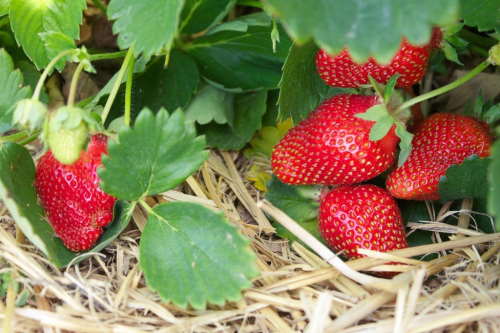 Other good options:
Other good options:
Eggplants, peppers, and other nightshades are great choices with a variety of culinary uses. Just be sure to give them stakes or allow them ample room to grow. Eggplants in particular are happiest when they have about three and a half months to fully fruit, so plan accordingly.
Leafy greens
Greens, like root veggies, are easy to grow and perfectly suited to straw bale gardens. Try the classic and versatile greens below to make the most of your growing season.
Lettuce
Lettuce is the classic salad green and can be grown in both the spring and fall, but stagger your plantings—it grows quickly. For uninterrupted harvests, plant new lettuce seeds every two weeks. Keep in mind that, if you reuse the bales, the straw may become too loose after 3-4 plantings and you’ll need to replace them. Lettuce grows best with a constant supply of compost and nitrogen-heavy fertilizers, so add some to the bale 2-3 weeks after each planting.
Spinach, kale, and chard
They’re easy to grow and require minimal maintenance. All three can grow well into the chilly months for year-round nourishment. They’re perfect for salad, sautees, and more, and really help you make the most of your straw bale space. Plant spinach and kale in the early spring and then again in the fall; they tend to lose their delicious flavor when summer heat sets in. Chard is the most versatile of the three: a spring planting will keep you busy harvesting until first frost.
Herbs
Growing your own flavoring and garnish makes the gardening experience all the more fulfilling, and herbs are just as simple to plant and harvest as leafy greens.
Basil
Basil can be used to season a variety of dishes—particularly of the Italian variety—but it shouldn’t be planted until after the last frost of the season. It grows best in full sunlight, and is ready to harvest once the plant starts growing buds.
Cilantro
Cilantro (coriander) grows fairly quickly and can usually be harvested four weeks after sowing its seeds. Like most herbs, it will grow into a healthier plant in full sunlight.
Parsley
Parsley is grown as a spring and summer crop in most regions. The more sun it has, the happier (and more flavorful) it’ll be.

Cruciferous vegetables
Like herbs, cruciferous vegetables are easy growers with a wide array of applications. They usually produce well into the fall and winter to help you extend your growing season.
Cauliflower and broccoli
Cauliflower and broccoli are great in-between-season crops because they can be harvested until at least the start of winter. Plant them as early as late-spring, give them access to full sun, and keep their bales moist, and you’ll have both delicious and versatile veggies into the winter. These plants grow best when their bales are treated with plenty of nitrogen-rich fertilizer.
Cabbage
Cabbage is best harvested in late fall, and looks stunning when its leaves burst from a straw bale. Be sure to plant cabbage where it can get at least six hours of full sun each day. Like cauliflower and broccoli, it does best in bales treated with nitrogen-rich fertilizers.
How many plants should you plant per bale?
The plants you choose will determine how many you can grow in each bale. The seed packet should give you a guide to spacing but, if in doubt, always allow more space than you’d expect when you look at the baby plants, and you can’t go wrong.
You can also grow a mixture of plants within each bale, perhaps a salad mix of tomato, cucumber and lettuce.

When the power goes out, your safety and comfort is important.
Protect your home or business with a new fully automatic standby generator. Maintain your security system, lighting and air conditioning to keep your family or business safe and comfortable through any power outage
Enjoy the total peace of mind that comes with knowing you have a constant and reliable power supply for your home or business in with a standby generator from Alternate Power Solutions. From everyday necessities like heating, cooling, refrigeration and lights, to daily essentials like cooking, laundry or kids bath times. Power outages are occurring more frequently than ever and lasting longer with devastating effects.
Stand up to unpredictable weather and unforeseen outages with the most trusted name in residential standby power with backup generators for homes. If the power ever goes out, your General standby generator goes on – automatically – protecting you and your home 24/7.

Books can be your best pre-collapse investment.
Carnivore’s Bible (is a wellknown meat processor providing custom meat processing services locally andacross the state of Montana and more. Whether your needs are for domestic meator wild game meat processing)
The Lost Book of Remedies PDF ( contains a series of medicinal andherbal recipes to make home made remedies from medicinal plants and herbs.Chromic diseases and maladies can be overcome by taking the remediesoutlined in this book. The writer claims that his grandfather was taughtherbalism and healing whilst in active service during world war twoand that he has treated many soldiers with his home made cures. )
Easy Cellar(Info about building and managing your root cellar, plus printable plans. The book on building and using root cellars – The Complete Root Cellar Book.)
The Lost Ways (Learn the long forgotten secrets that helped our forefathers survive famines,wars,economic crisis and anything else life threw at them)
LOST WAYS 2 ( Wordof the day: Prepare! And do it the old fashion way, like our fore-fathers did it and succeed longbefore us,because what lies ahead of us will require all the help we can get. Watch this video and learn the 3 skills that ensured our ancestors survival in hard times offamine and war.)
Growing Vegetables in Straw Bales (Straw is Like a Sponge and Holds an Amazing Quantity of Water) - PrepperFortress
If you're gonna fight, fight like you're the third monkey on the ramp to Noah's Ark... and brother its starting to rain. Join our efforts to Secure America's Borders and End Illegal Immigration by Joining ALIPAC's E-Mail Alerts network (CLICK HERE)


 226Likes
226Likes LinkBack URL
LinkBack URL About LinkBacks
About LinkBacks




 Reply With Quote
Reply With Quote


Brown University Shooting (early report) | SPACESHOT76
12-14-2025, 08:52 AM in General Discussion